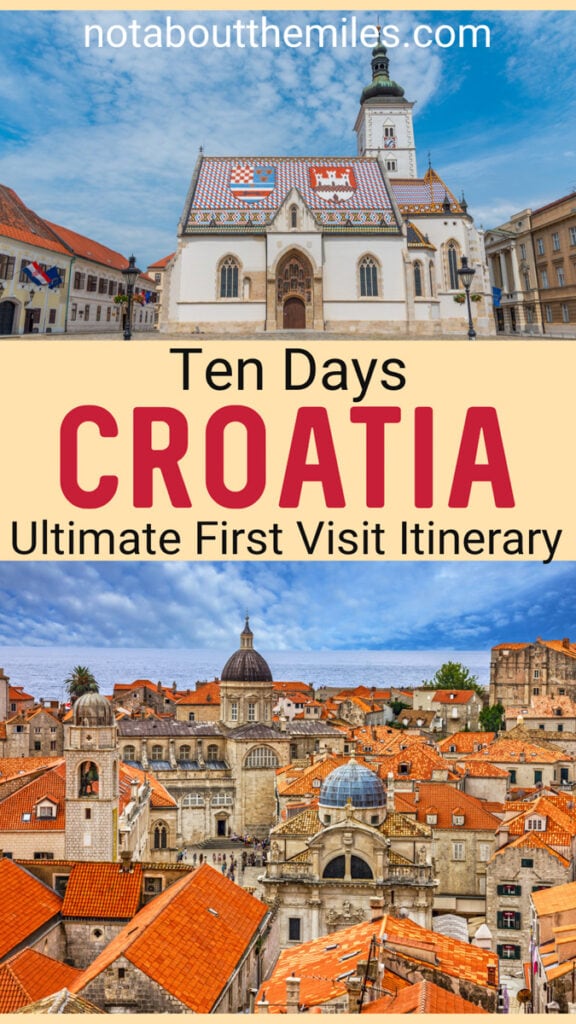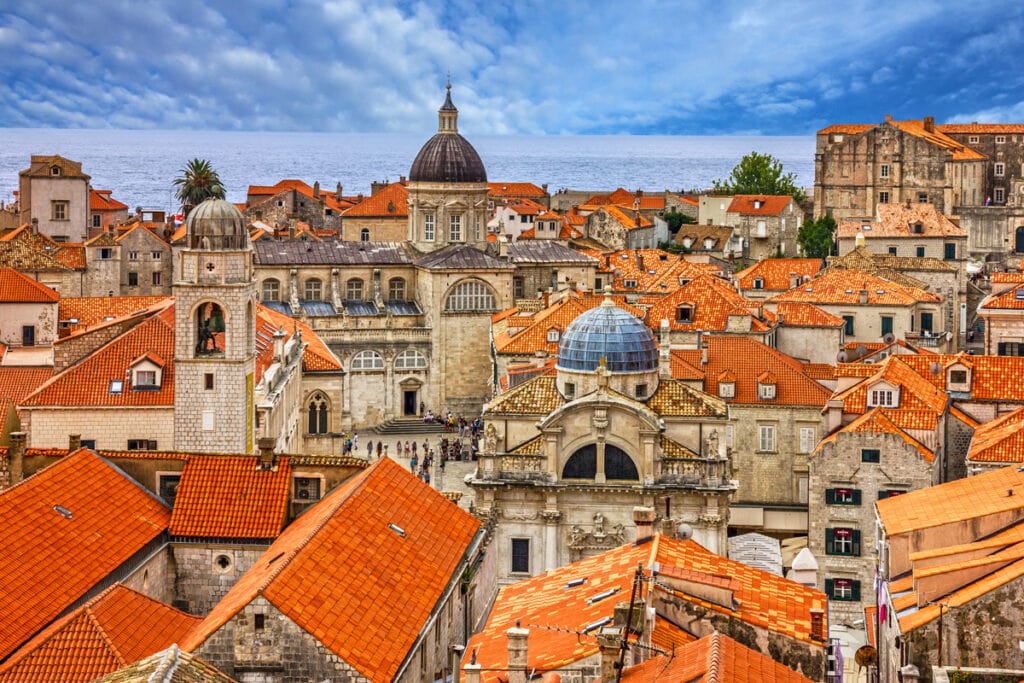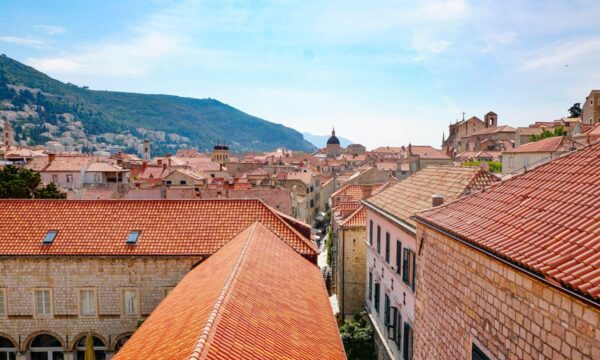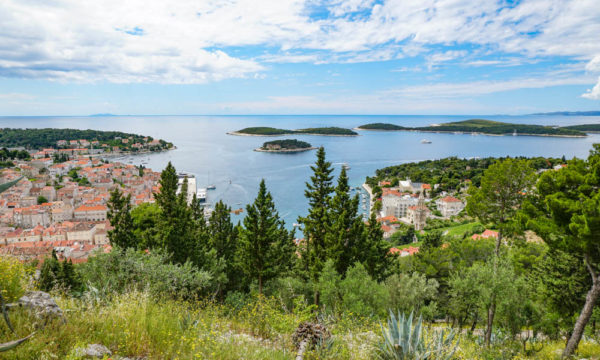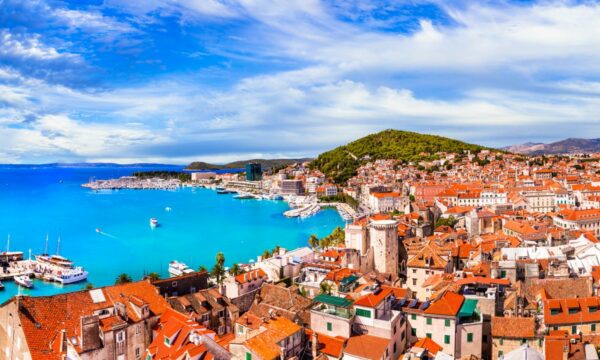Planning a visit to Croatia and trying to craft the ultimate 10 days in Croatia itinerary?
Croatia is incredibly beautiful. It has a little bit of everything you could want in a holiday destination, from beautiful beaches and islands to wonderful waterfalls and charming old towns to splendid historic cities.
From walking the walls of Dubrovnik to wandering Diocletian’s Palace in Split, and from taking in the views from Hvar Town’s fortress to lazing on the picture-perfect beaches, there are many Croatian experiences you’ll want to add to your itinerary.
No longer an undiscovered paradise, Croatia is nevertheless very worth visiting. It is a place of incredible natural beauty, with a lively laid back vibe, and great food and wine options.
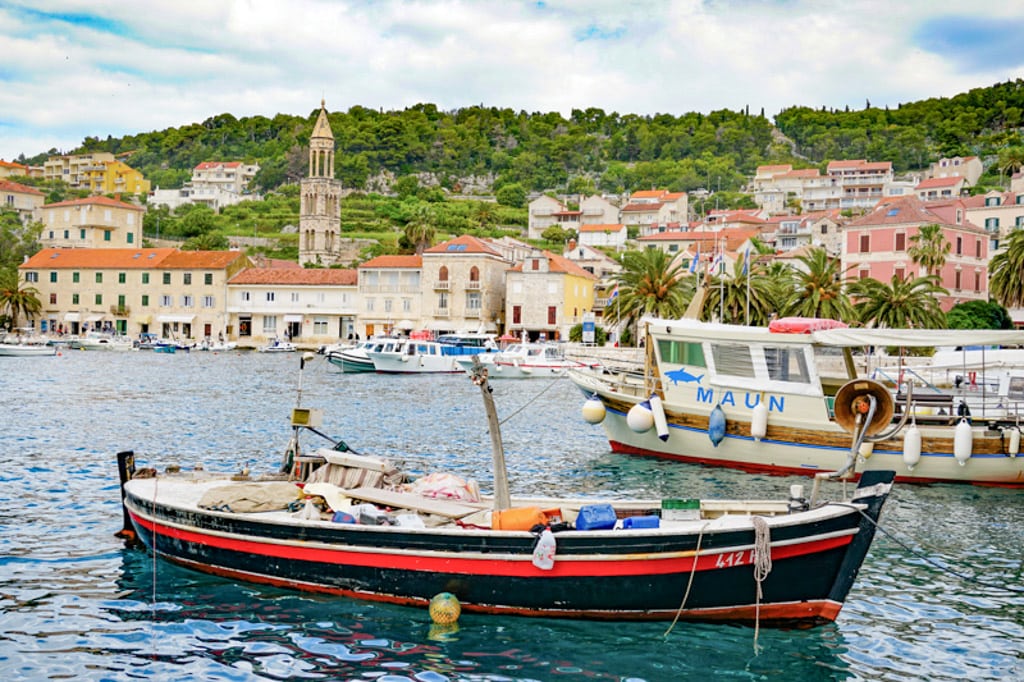
Some links on this page may be affiliate links. If you click an affiliate link and make a purchase, we may receive a small commission, at no extra cost to you. For more details, refer to our disclosure.
We spent almost three weeks in Croatia on our first visit, and enjoyed every single moment, so much so, that we’ve gone back several times since then.
We realize that not everyone has the luxury of spending three weeks on vacation, so we’ve distilled the best of Croatia into this 10-day itinerary.
Our in-depth article describes where to go in Croatia and what to see and do, plus great places to stay and eat.
Read on to discover our perfect 10 day itinerary for Croatia!
Croatia Itinerary for First-Time Independent Travelers
Visiting Croatia is one of the best ways to spend 10 days in Europe.
Located on the shore of the Adriatic in the northwest part of the Balkan Peninsula, Croatia’s coastal beauty is the stuff of legend.
Photos of picturesque orange roofs against the gorgeous deep blue of the sea are enough to make you want to book airplane tickets immediately.
But Croatia’s interior is stunning as well. Plitvice Lakes National Park, with its many beautiful waterfalls, should be on everyone’s bucket list. Zagreb has an understated appeal that will draw you in, and the Baroque towns scattered about the area are super charming.
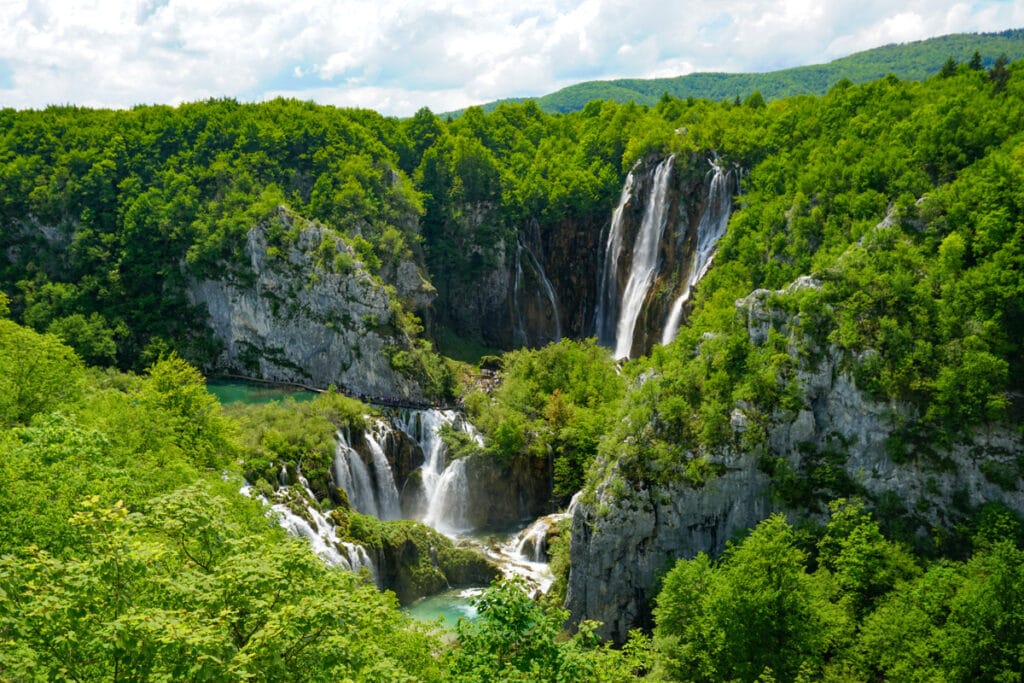
The Istrian interior, with its lush vineyards and charming hill towns, is reminiscent of Tuscany, with wine, cheeses, and truffles.
While 10 days in Croatia will allow you to cover many of the major sights on offer, there so many beautiful places to visit in Croatia that you could spend 3 or 4 weeks here!
Our Croatia itinerary is targeted toward the first-time visitor to the country, with a focus on the most iconic sights and experiences. It is an eclectic blend of historic cities and natural sights.
Here then, is how to experience the best of Croatia in 10 days:
Day 1: Arrive in Zagreb, explore Zagreb
Kick off your Croatia itinerary in Zagreb, the capital.
With its stately Austro-Hungarian architecture, historic Upper Town, many museums, on-point culinary scene, and coffee culture, Zagreb is a fun city to explore.
A much underrated destination in Croatia, Zagreb will charm you, especially if you enjoy architecture and history.
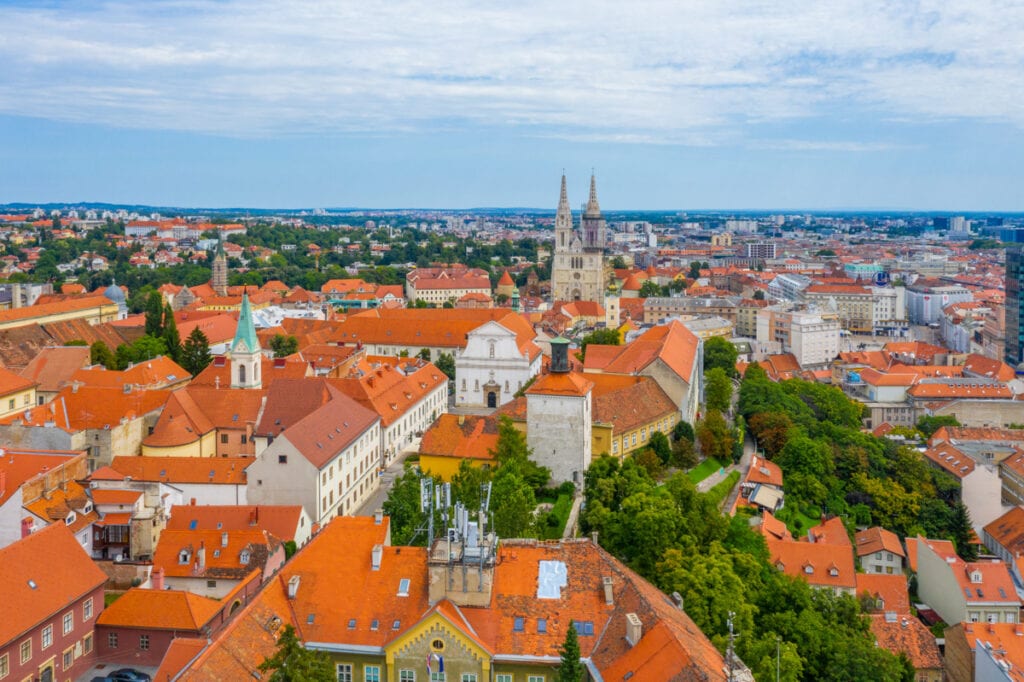
Getting into Zagreb
Zagreb has an international airport and is well-connected to many other parts of Europe and beyond.
From the US, you’ll likely fly into Zagreb via another European city. London, or Frankfurt or Munich, offer many flights to Zagreb and make for great stopovers.
The airport in Zagreb, Franjo Tudman Airport, is located 15 kilometers (about 9.3 miles) from the city center.
To get to the city center, you can book a private transfer, or take a taxi or Uber. We did a private transfer, and we recommend booking a transfer over a taxi: you won’t have to wait, or worry about whether the meter is working.
There is also a bus that leaves the airport every 35 to 40 minutes, and stops at various places in the city on its way to Kvaternik Square. It’s a cheaper option if you do not have too many bags.
You will not need a car in Zagreb, so if you plan to do this itinerary by car, you can pick up your rental in the city center when you are ready to head to your next destination.
Getting Around in Zagreb
For the one day in Zagreb itinerary we suggest, you can walk everywhere. Zagreb’s historic core is fairly compact, with major sights set not too far apart.
However, Zagreb has an efficient system of trams and buses if you need to use public transport. You can also use taxis (but make sure the meter is working and on) or Uber.
There is a funicular that can take you to the Upper Town if you do not wish to walk up the hill.
What to See and Do in Zagreb
A walking tour is an efficient way of touring the major sights. Check out this highly rated 2.5 hour walking tour that also includes a ride on the funicular!
Start at the central Ban Jelačić Square, where you can admire the architecture and enjoy people watching. At the square, you will find the Zagreb 360° observation deck, which offers fabulous views over the city.
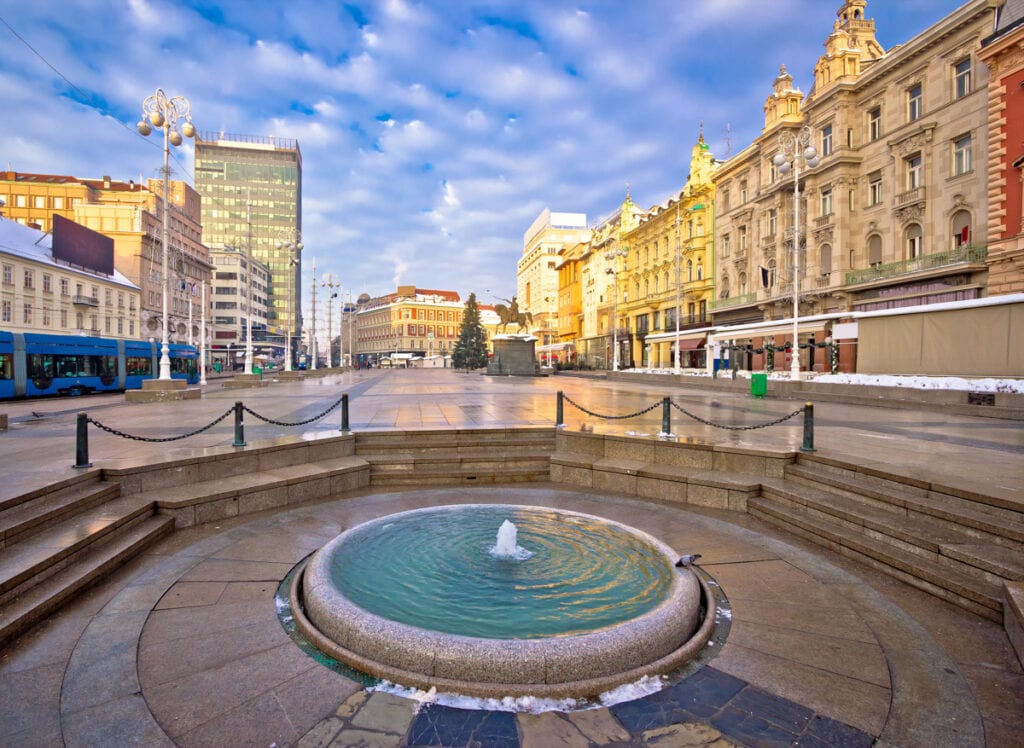
Near the square is the Zagreb Cathedral, officially the Cathedral of the Assumption of Mary. The spires suffered damage in an earthquake in 2020, so the facade isn’t complete, but it’s an imposing structure nonetheless.
Walk through the historic Stone Gate, where you’ll find a small chapel, and past the oldest pharmacy in Zagreb, dating back to the mid 14th century.
Saint Mark’s Church is famous for its tiled roof, which bears the coats of arms of Croatia, Dalmatia, and Slavonia, as well as the emblem of Zagreb.
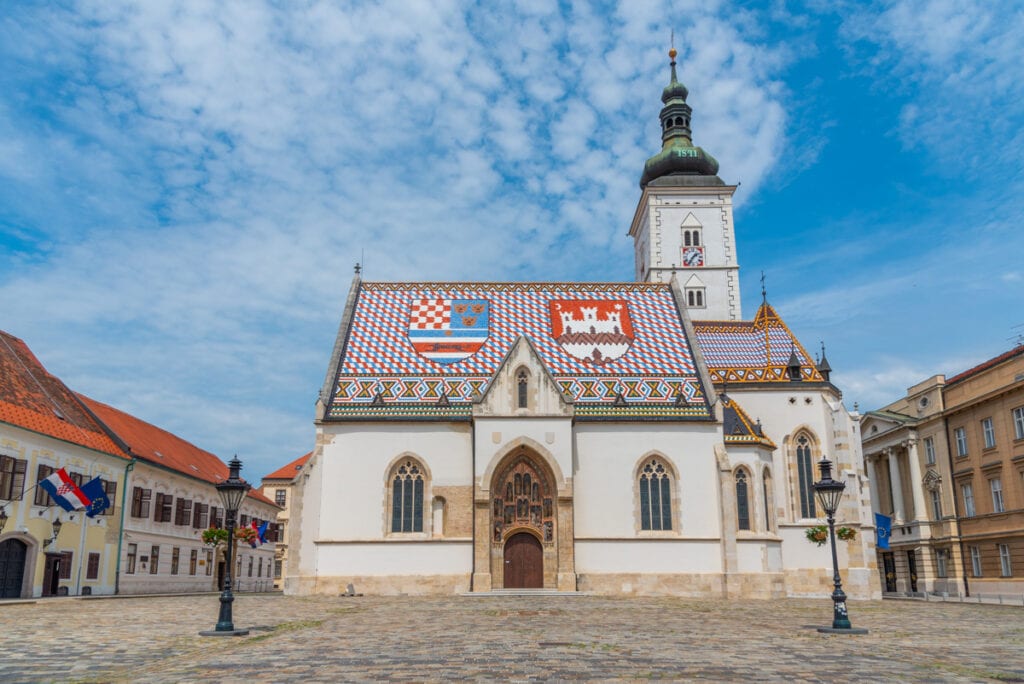
The Museum of Broken Relationships is a small quirky museum worth a browse before you head to the Lotrščak Tower, which you can climb for 360-degree panoramic views.
Take the funicular down for fun or walk down the Strossmayer Promenade to get back to the Lower Town, where you can stroll Tkalčićeva Street, lined with restaurants and bars.
Lower Town features beautiful architecture, streets lined with shops and cafes, if you are up for more walking.
Museum buffs can pick from a number of interesting options.
Or you can take a taxi or the bus to beautiful Mirogoj Cemetery, where the architecture will wow you.
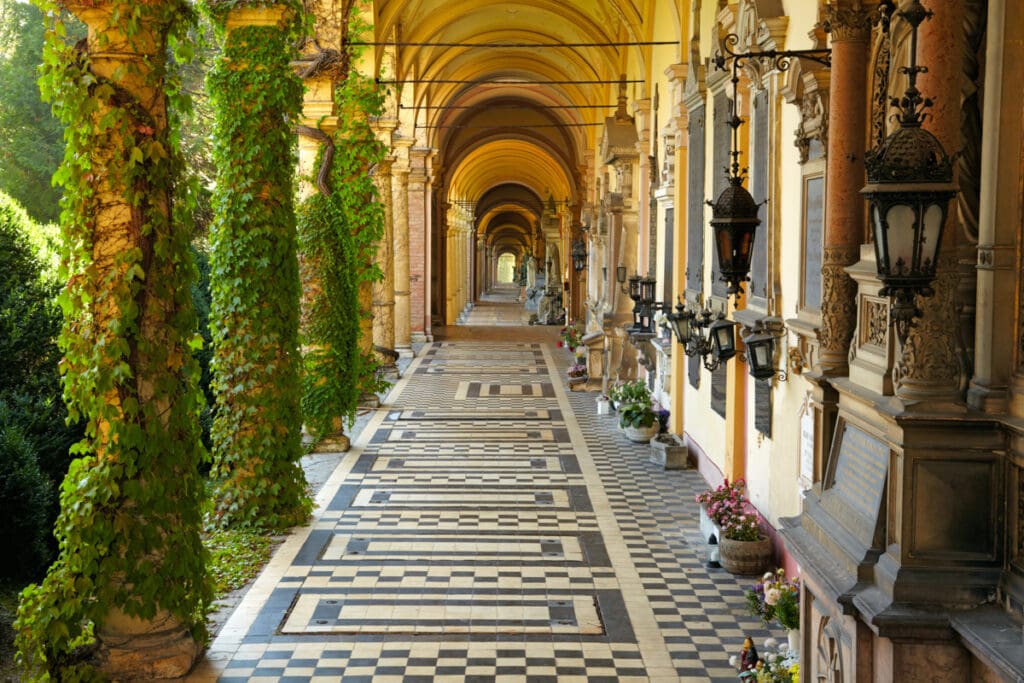
Enjoy dinner and drinks at Dubravkin Put, located just a short distance from the center. Our dinner here was one of the best meals we’ve had in Croatia.
Where to Stay in Zagreb
Luxury: The Esplanade Zagreb was built in 1925 for passengers of the Orient Express. Located by the Zagreb train station, the hotel is about a 12 minute walk from Ban Jelacic Square.
The building is stunning. The rooms and suites are spacious and luxuriously furnished, and the marble bathrooms decadent. The hotel offers valet parking. The buffet breakfast is highly rated.
Luxury: Hotel Amadria Park Capital Heritage Zagreb is housed in a gorgeous early 20th century structure. With Art Deco and Art Nouveau influences, the hotel is classic Zagreb.
Rooms are spacious and well-furnished, breakfasts are rated exceptional, and service first class.
Mid-Range: Hotel Dubrovnik is located by Ban Jelacic Square, very convenient for sightseeing and close to numerous restaurants and bars. It has a summer terrace that faces the square.
Air-conditioned rooms are comfortable and well appointed. The breakfast buffet is highly rated.
Mid-Range: Hotel Jagerhorn is located close to Ban Jelacic Square in a passageway connecting the Lower and Upper Towns, and is reportedly the oldest hotel in Zagreb. It was refurbished in 2015.
The hotel offers just 18 rooms, elegantly appointed, and features a terrace and gardens.
Day 2: Travel to Plitvice Lakes National Park, explore Plitvice Lakes
One of Europe’s best national parks and one of Croatia’s most popular travel destinations, Plitvice Lakes National Park is the stuff of picture postcards. The enchanting landscapes will captivate you.
The park is a must-visit on any Croatia trip!
Plitvice Lakes features sixteen stunning lakes, connected to one another by hundreds of cascades, big and small. The landscape is unbelievably beautiful.
A system of boardwalk trails and trails along the shores of the lakes allows you to explore the beauty of the natural landscapes up close. A day at Plitvice Lakes is a magical day in nature!
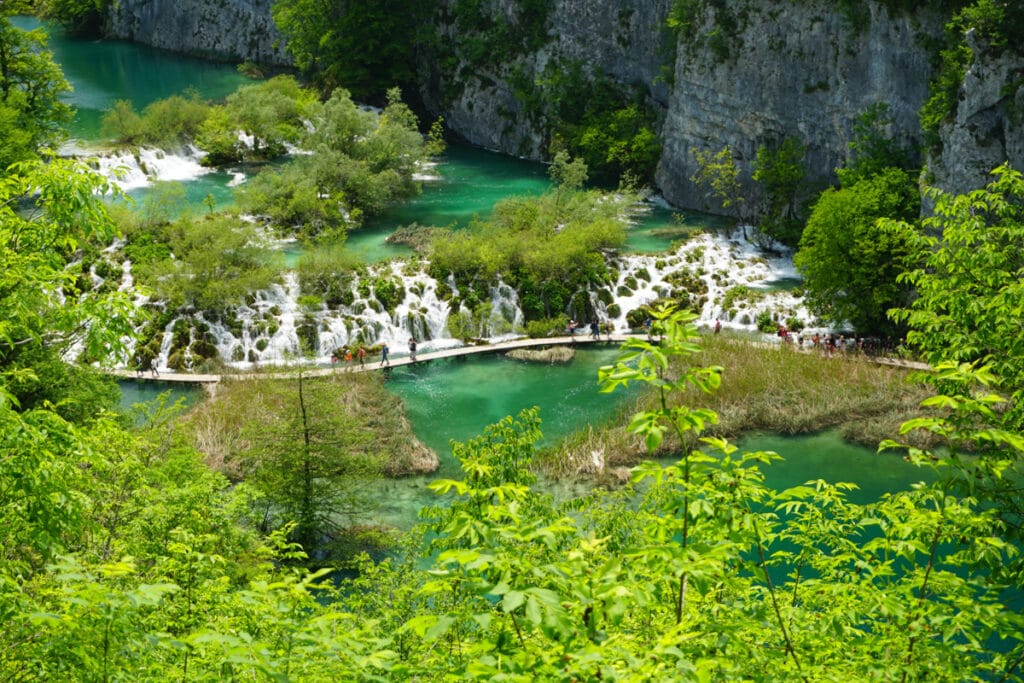
Getting to Plitvice Lakes
Renting a car and driving yourself is the most flexible transport option for this Croatia itinerary. It is 130 kilometers from Zagreb to Plitvice Lakes, and the drive should take about 2 hours in normal traffic.
Looking to rent a car for your Croatia trip? Consider Discover Cars! They work with numerous car rental agencies to get you the best deal.
Check availability and book your Croatia car rental now!
If you do drive yourself, you may want to stop at Rastoke, where the Slunjčica river flows into the Korana river, creating some pretty waterfalls. The village is known for its many historic watermills.
If you want to arrive by public transport, you can take the bus. There are several departures each day from Zagreb, some faster than others. The average time is about 2 hours and 20 minutes.
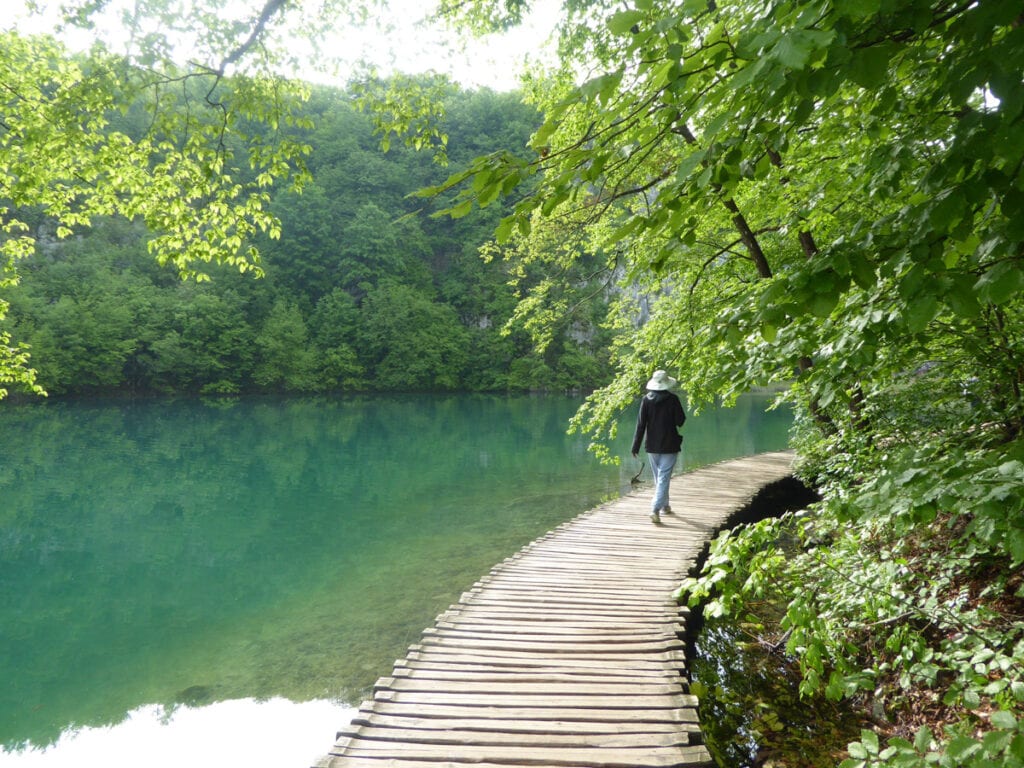
While Plitvice Lakes National Park is one of the most popular day trips from Zagreb, we suggest overnighting so you can stay in the park late into the day and experience it when it’s quieter and less crowded.
But if you prefer not to move often, and like the structure of a guided tour, this highly-rated full-day tour includes a stop at Rastoke.
Getting Around in Plitvice Lakes National Park
There are several different hiking routes through Plitvice Lakes National Park, organized based on the entrance where you begin, the time you have, and your stamina.
The park also offers a scenic boat ride that gets you from the Lower Lakes to the Upper Lakes, and a shuttle bus that you can use to return to the entrance after your explorations.
What to See and Do in Plitvice Lakes National Park
Enjoy the magnificent natural beauty!
The park is split into the Lower Lakes section, and the Upper Lakes section. Veliki slap, the tallest and mightiest waterfall in the park, is located at the lower level.
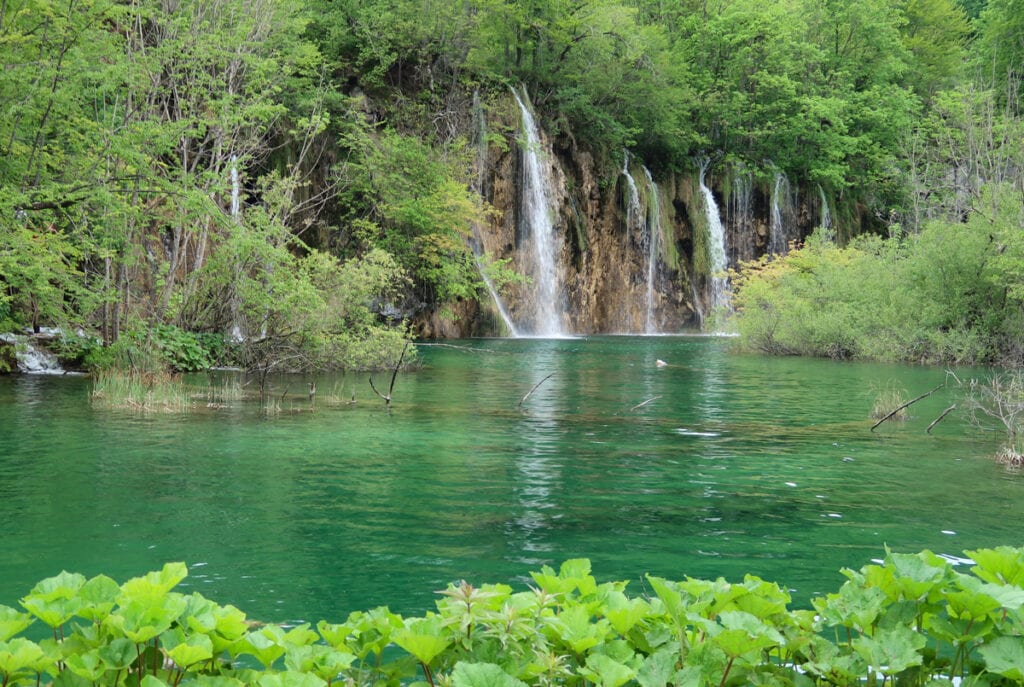
The sixteen lakes in the park range in color from turquoise to deep green, depending on the light. Apart from Veliki slap, there are numerous beautiful cascades, especially in the Upper Lakes section.
Look for wildflowers in the spring and early summer, and leaf color in the fall. You may also spot wildlife and birds as you walk the trails in the park.

The longest routes in the park take 4 to 6 hours, with photo stops, so if you arrive at the park after lunch, you can stay later into the evening, when it’s quieter.
Where to Stay at Plitvice Lakes
Mid-Range: Hotel Dejenija is located 4 kilometers (about 2.5 miles) from the park entrance. We stayed here on our first visit to Plitvice Lakes National Park and found it both comfortable and convenient.
Rooms are spacious and well-appointed, and the onsite restaurant offers well-made local cuisine.
Mid-Range: Jezero Hotel is located 200 meters (just 0.1 mile) from the park entrance. Some rooms even have views of the lakes and the forests!
Rooms are comfortable and the onsite restaurant offers a nice breakfast and a buffet dinner. The hotel offers saunas, a hammam, and a whirlpool if you want to relax after you explore.
Day 3: Travel to Zadar, explore Zadar
The coastal city of Zadar has a charming Old Town. With picturesque Roman ruins, beautiful churches, and lively squares, Zadar is well worth visiting in its own right.
But you can also do day trips from Zadar to other places worth seeing in the region: from national parks and islands to historic cities and towns.
On this Croatia itinerary, you’ll spend two nights in Zadar. Plan to arrive as early in the day as you can, since there’s a lot to see and do in Zadar.
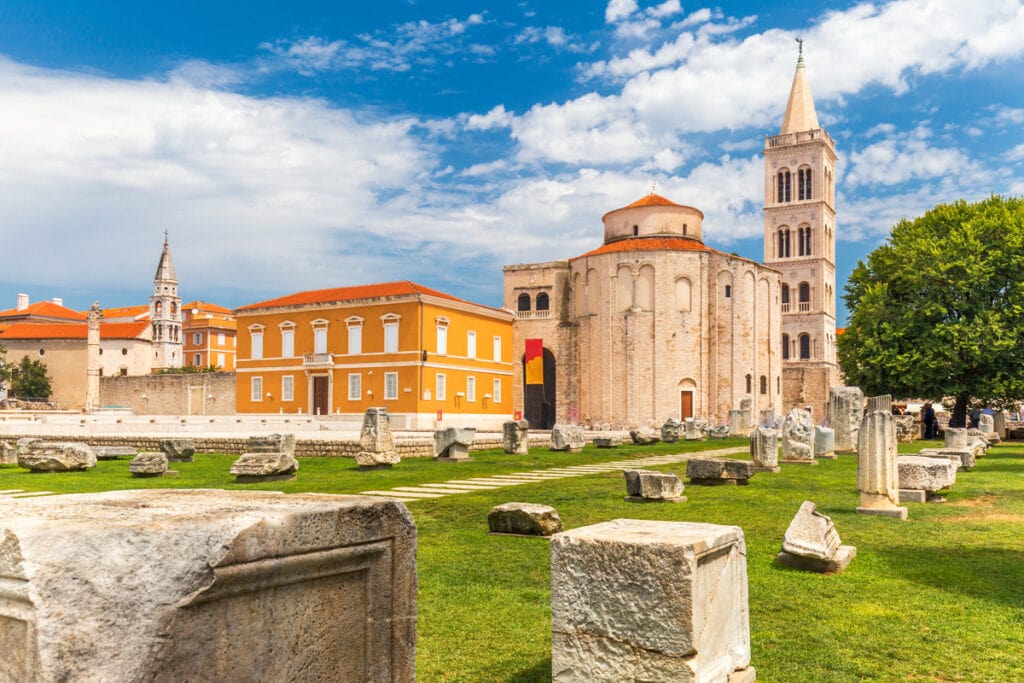
Getting into Zadar
Zadar is located 133 kilometers (about 83 miles) from Plitvice Lakes. If you are roadtripping Croatia, the drive takes about 1 hour and 45 minutes in normal traffic.
If you plan to use public transport, the bus takes about 1 hour and 45 minutes on average, with several departures each day. From the bus station in Zadar, take a taxi or the local bus to the Old Town (about 10 minutes).
To book bus tickets for Croatia in advance, consider Omio. The website is in English, and we found the booking experience easy and hassle-free. They do charge a small service fee but we thought it was well worth the convenience!
Check schedules and book your Croatia bus tickets now!
Getting Around in Zadar
If you follow our suggestions for things to do in Zadar in one day, you will spend much of your time in Zadar Old Town, which is compact and very walkable.
What to See and Do in Zadar
Old Town Zadar makes for a pretty wander, with its narrow alleys, historic squares (some with old wells!), and many landmarks. A guided walking tour provides a great overview if you enjoy history and architecture.
Stroll the ruins of the Roman Forum, located by the water. It was built during the reign of Emperor Augustus. Nearby, the massive Saint Donatus Church is today a concert venue.
The Zadar Cathedral, dedicated to Saint Anastasia, is a beautiful structure, reminiscent of churches in Italy. Climb to the top of the standalone bell tower for panoramas in every direction.
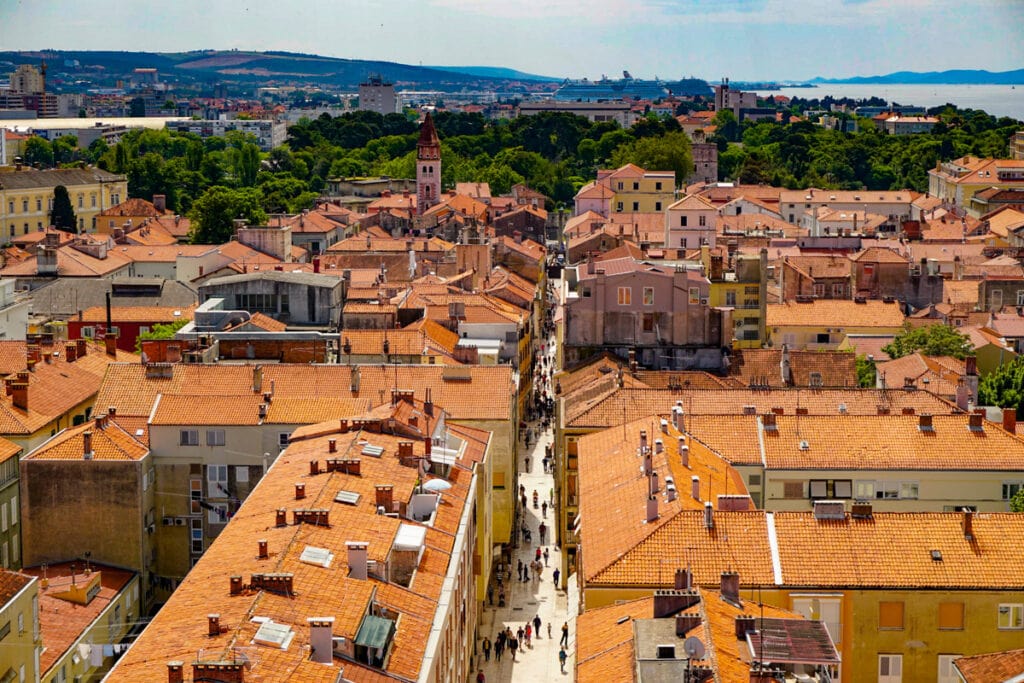
Admire the architecture in Narodni Trg, the main square, and snap photos of the picturesque wells at the Trg Pet Bunara. Plan to be here at lunch time: the Pet Bunara Restaurant, on the square, offers delicious food and has its own olive oil.
Zadar’s green market is worth browsing if it’s open when you visit. The stalls are colorful, and the produce abundant and fresh. We picked up some delicious cherries and figs here for snacking.
In the late afternoon, stroll the Riva, or the waterfront promenade, where you will find the Sea Organ, a system of underground tubes created by architect Nikola Bašić that allows you to enjoy the “music” made by the waves and the wind.
Relaxing on the marble steps, watching the sun set and listening to the Sea Organ, is one of the most relaxing things to do in Zadar. And once it’s dark, walk the few steps to watch the lights (powered by solar energy) come on at the Greeting to the Sun installation.
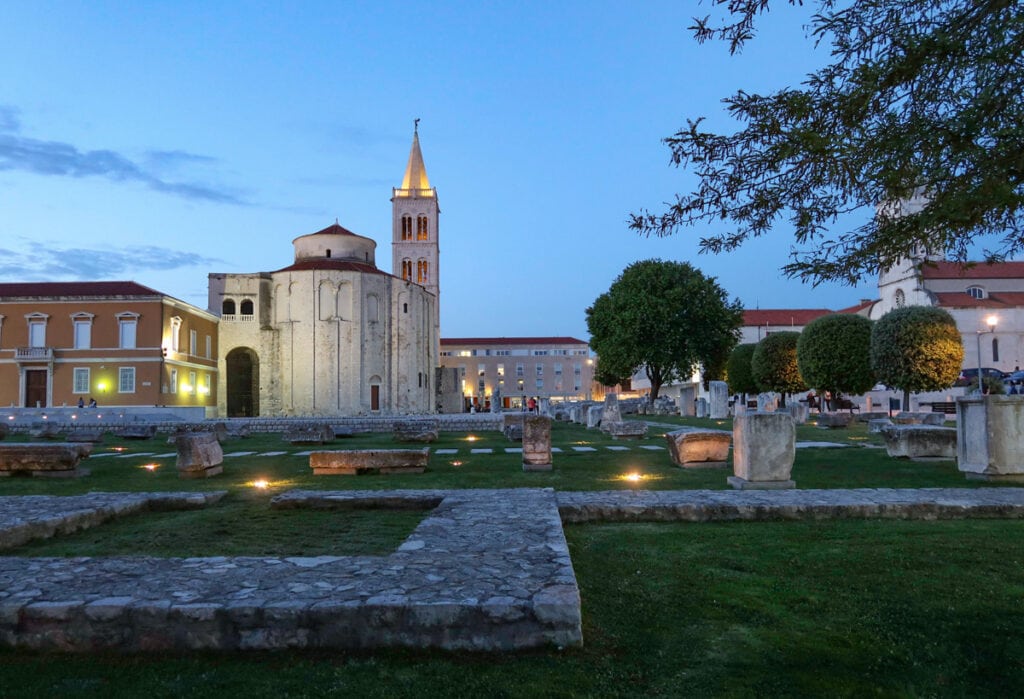
Where to Stay in Zadar
Mid-Range: Art Hotel Kalelarga is located just off Narodni Trg. Rooms are elegantly furnished in neutrals and service is first-class.
We stayed here on our first visit to Zadar and loved our spacious top-floor room with its separate sitting area and large bathroom.
Breakfast is excellent and served in the in-house cafe-restaurant.
Mid-Range: Hotel Bastion is a boutique Relais & Châteaux property located just inside Old Town Zadar, convenient for sightseeing and dining.
Rooms are spacious and well-appointed, with large bathrooms. Some rooms feature views over the water. Breakfast is well-reviewed.
Day 4: Take a day trip from Zadar to Krka National Park and Sibenik
Krka National Park is known for its waterfalls, especially the impressive Skradinski buk. While you cannot swim in the plunge pool any more, the park is still worth visiting for its serene natural beauty.
Sibenik is a charming and historic city just a 15-minute drive from Krka National Park. It is home to a couple of UNESCO World Heritage Sites and the historic core is charming.
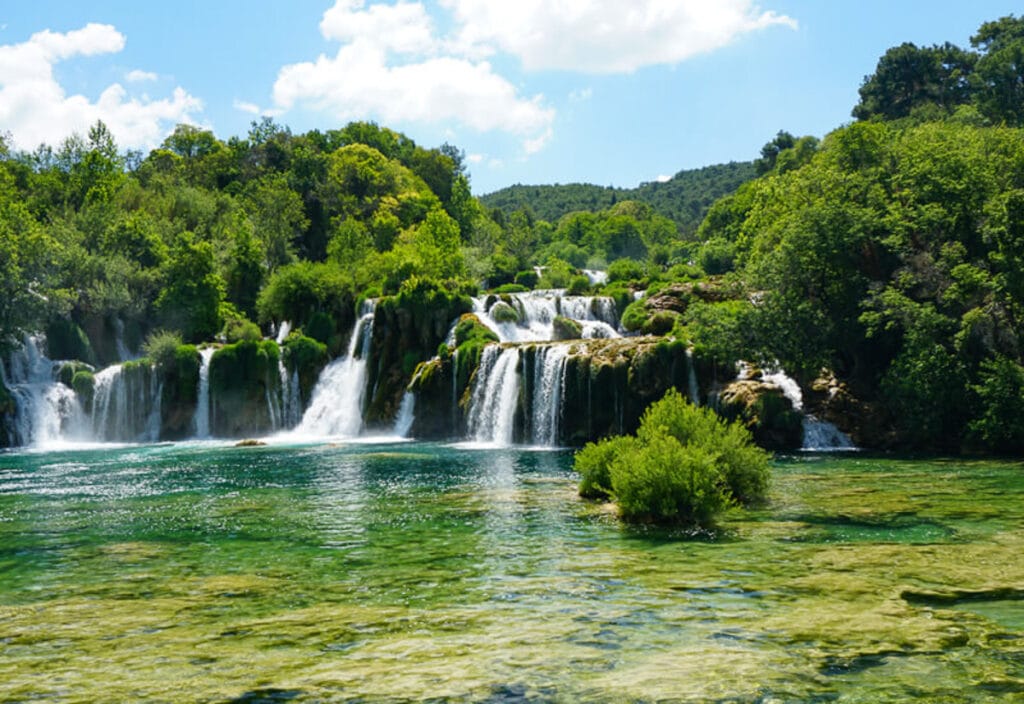
Getting to Krka National Park and Sibenik
If you have a car, you can drive from Zadar to Krka National Park in about 50 minutes in normal traffic. From the park, Sibenik is about a 15-minute drive, and you can drive from Sibenik to Zadar in about one hour.
The bus is a convenient option if you do not wish to drive. The direct bus from Zadar to Skradin, a gateway to Krka National Park, takes about one hour, and there are several departures. From Skradin, a boat ride gets you into the park.
A local bus will get you from the park to Sibenik in about 15 minutes. The journey from Sibenik to Zadar by bus takes a little over one hour, with multiple departures everyday.
If you like the idea of a structured tour, this well-reviewed tour combines Sibenik with Krka National Park for a full-day excursion from Zadar.
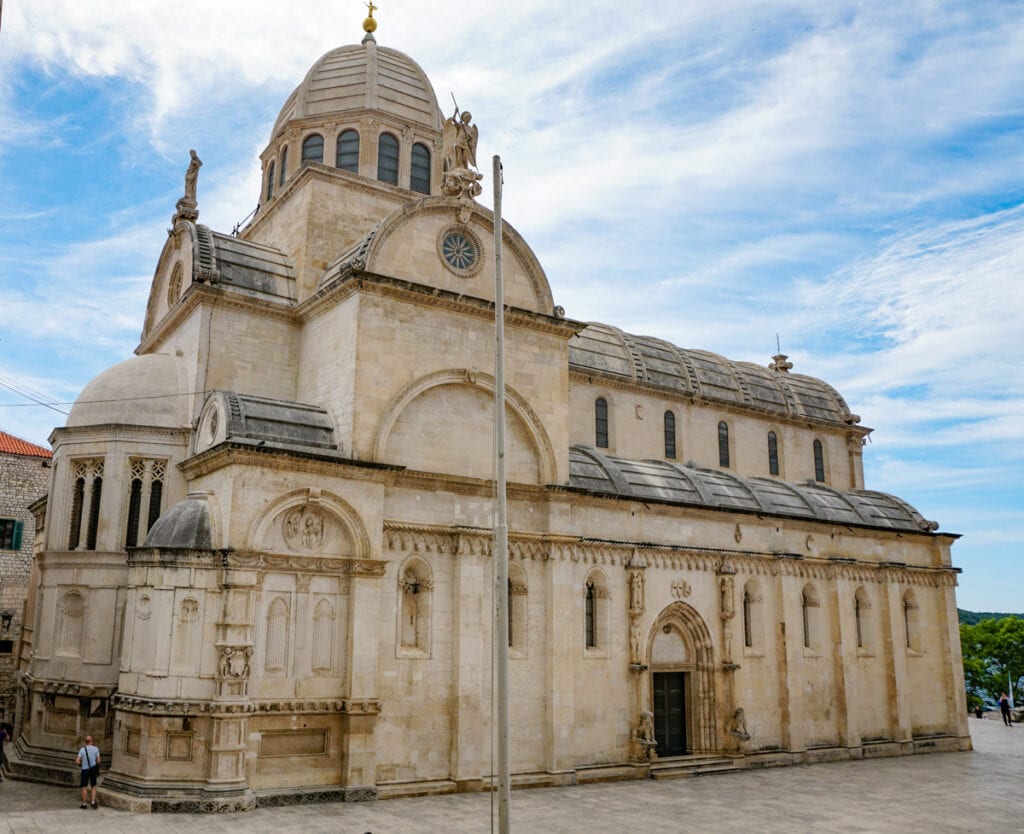
Getting Around in Krka National Park and Sibenik
There are walking trails in Krka National Park that take you to main sights like Skradinski buk. You can also take the excursion boats to sights inside the park. We have a complete guide to Krka National Park if you plan to visit independently.
The historic core of Sibenik is very compact and you can walk everywhere. In fact, wandering the streets is one of the best things to do here!
What to See and Do in Krka National Park and Sibenik
In Krka National Park, Skradinski buk is the biggest draw. The massive waterfalls are actually a network of 17 karstic cascades, with a total width of 200 to 400 meters (about 650 to 1,300 feet).
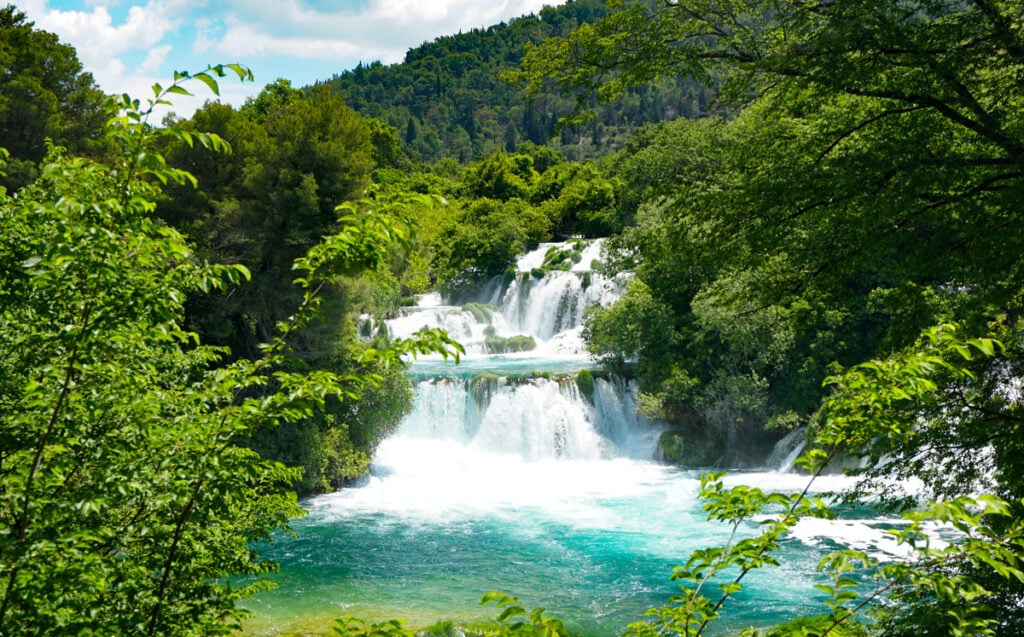
You can walk a boardwalk trail through the pretty landscape to get to the viewing area for Skradinski buk. The trail allows you to get close to the Krka River, smaller cascades, wildflowers in the spring, and leaf colors in the fall.
Roski slap is the other popular waterfall in the park. While it is nowhere as impressive, you can swim in the waters near the waterfall and enjoy the necklace cascades above the main waterfall.
Do not miss the overlook that features a stunning view of the picturesque little island that houses the Visovac Monastery!
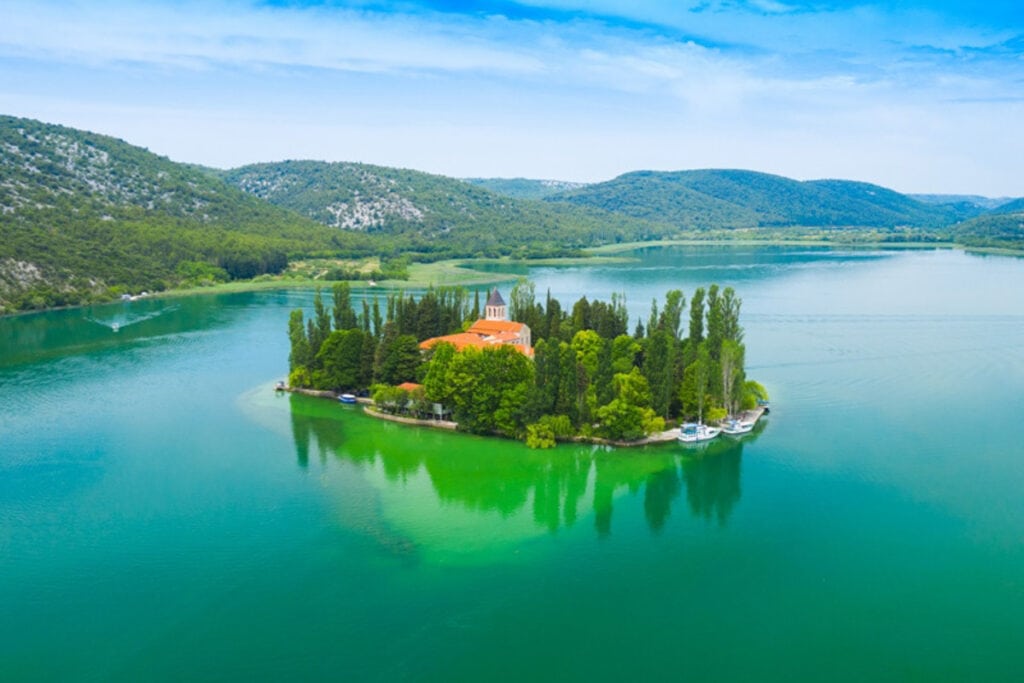
In Sibenik, you will be awed by the size and majesty of the Cathedral of Saint James. Made entirely of stone, the facade features a striking frieze that features 71 sculptured human faces.
Wander the historic core of Sibenik to admire the beautiful stone buildings and pretty squares. The colonnaded City Hall is especially lovely.
There are four medieval fortresses in Sibenik. Walk up to the hilltop Saint Michael’s Fortress for spectacular views over the rooftops of Sibenik and the Adriatic.
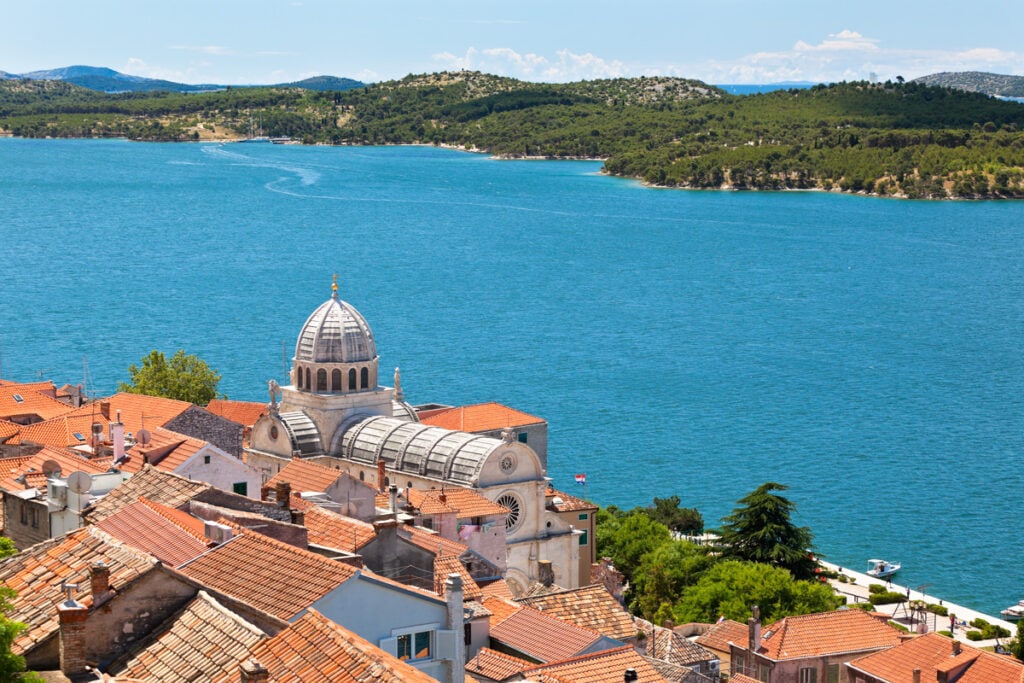
Day 5: Travel to Split, explore Split
Today you’ll continue down Croatia’s beautiful Dalmatian Coast to Split. Split is the second-largest city in Croatia, but it has a small-town feel once you are in the historic center.
Mainly known for Diocletian’s Palace, a UNESCO World Heritage Site, Split also has a beautiful Riva or waterfront promenade and is home to several museums, including the Ivan Meštrović Gallery, an art museum dedicated to the Croatian sculptor.
Split is also a great base from which to take trips to one or more of the idyllic Croatian islands.
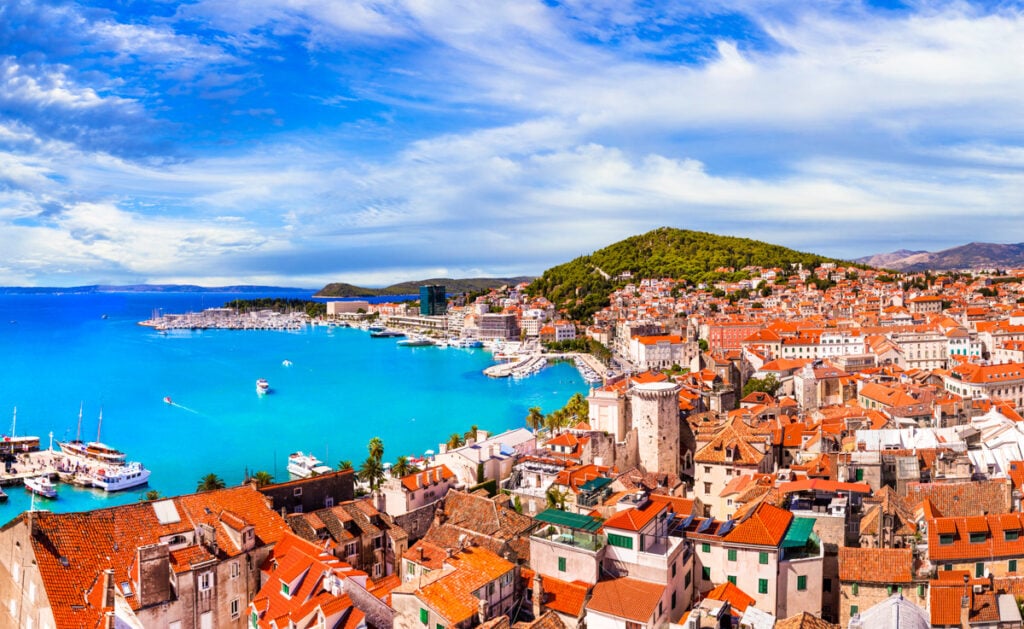
Getting to Split
If you are driving, the journey from Zadar to Split takes about 1 hour and 35 minutes in normal traffic.
If you plan to use public transport, you can take the bus from Zadar to Split. The journey takes about 2 hours and 35 minutes, and there are multiple departures everyday.
Plan to arrive early so you can maximize your sightseeing in Split!
Getting Around in Split
Split’s Old Town is very compact and you can walk everywhere. The waterfront promenade is just outside the gates of the town.
What to See and Do in Split
A walking tour is a great way to learn about the history as you explore Split’s Old Town! This highly-rated tour is led by a local historian that speaks fluent English and lasts a little under 2 hours.
Book this tour now!
Touring Diocletian’s Palace is one of the top things to do in Split. Built as a retirement residence for the Roman emperor, the palace is actually a complex that contained, besides his residence, a military garrison and a fortified town.
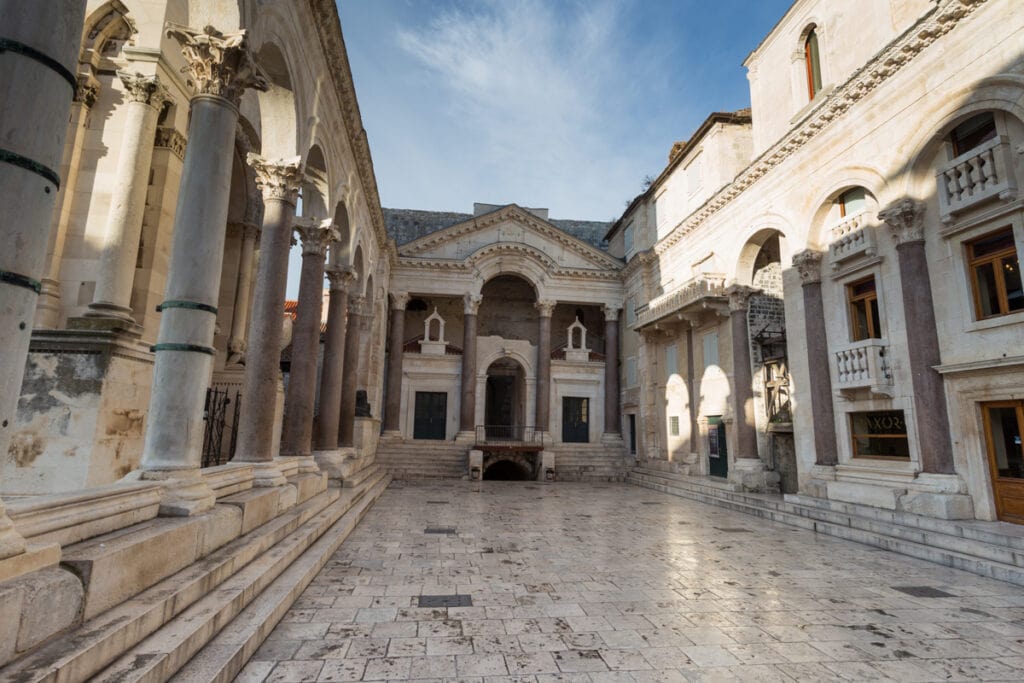
If you are a Game of Thrones fan, the cellars of the complex served as Daenerys’s Throne Room in Meereen.
The Split Cathedral lies within Diocletian’s Palace. Climb the graceful bell tower for fabulous panoramas over the city.
Narodni Trg, the main square in the Old Town, features many palaces. It’s a great place to have a drink and people watch.
Stroll the Riva, the waterfront promenade. Split’s marina is a great place to catch sunset.
if you enjoy art, visit the Mestrovic Gallery, housed in his villa on the Marjan Peninsula. Whether you are an art lover or not, you’ll want to stop by the huge statue of Grgur Ninski carved by the sculptor that’s located just outside the Golden Gate.
Walking distance from the Old Town are steps that lead up to a viewpoint on Marjan Hill. The viewpoint offers expansive views of the city and the sea. You can hike further up the hill if you wish!
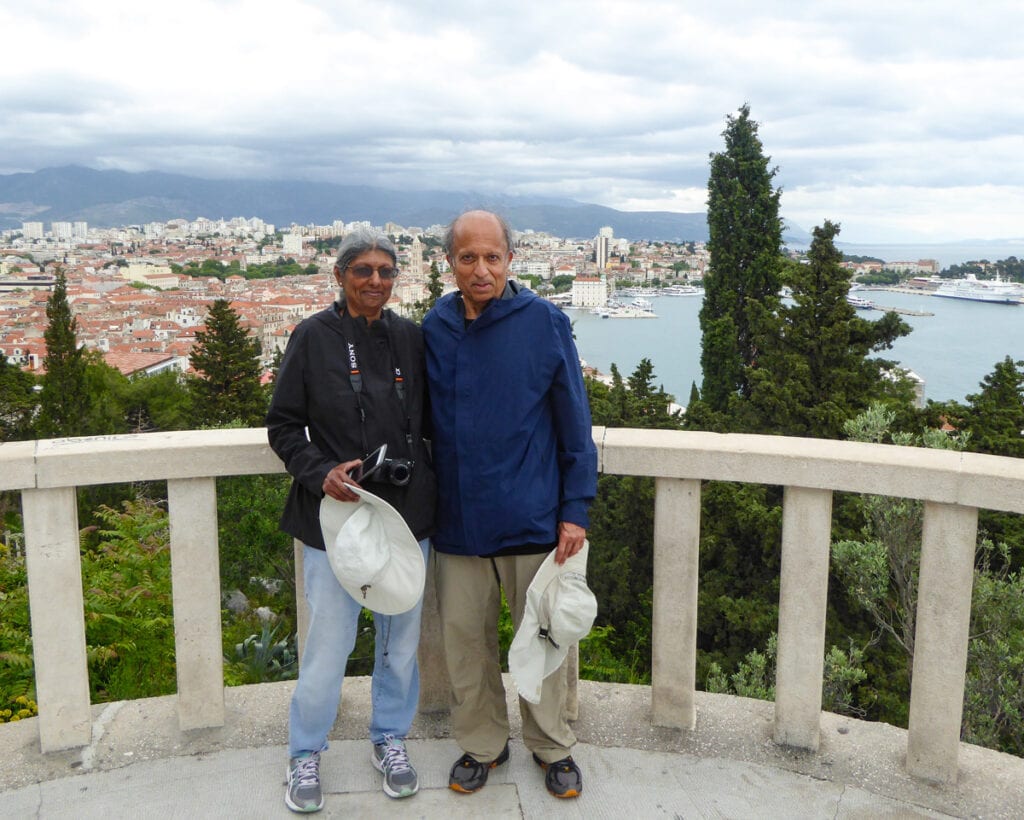
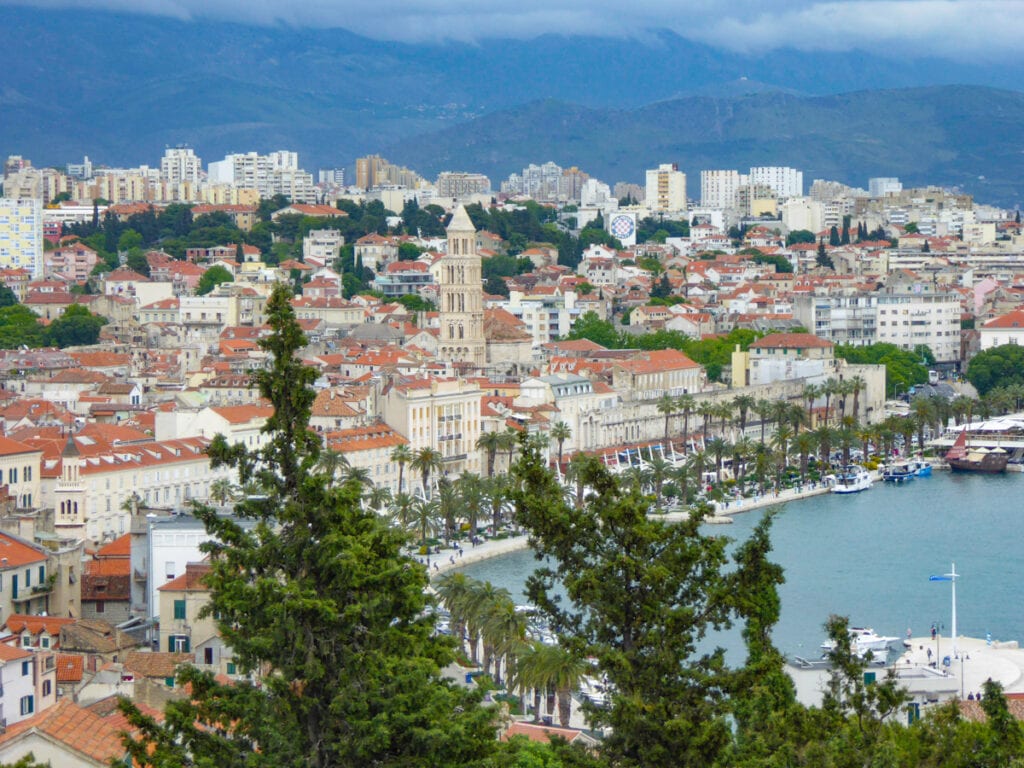
In the evening enjoy wine, with or without a food platter, at the well-known Zinfandel Food and Wine Bar.
For dinner, head to Konoba Fetivi, which offers Dalmatian meat and seafood dishes. Be sure to leave room for the apple strudel.
Where to Stay in Split
Luxury: Judita Palace Heritage Hotel is located on Narodni Trg, in a 16th century palace. Rooms feature exposed brick walls and upscale furnishings. The courtyard downstairs has a bar and restaurant. Breakfast is excellent.
We stayed here on our first visit to Split and found the service exemplary.
Luxury: Hotel Murum has a fabulous location inside Diocletian’s Palace. It’s a small hotel housed in a historic building, but has been carefully restored to preserve the antique appearance (think exposed brick walls!) while offering modern comforts. Breakfast here is highly rated.
Mid-Range: Piazza Heritage Hotel is located on the main square in Split. It is housed in a beautiful Art Nouveau palace, and rooms are decorated elegantly in Art Nouveau style as well. Some rooms offer views of the square.
Mid-Range: Heritage Hotel Antique Split is a family-run property located inside Diocletian’s Palace. The hotel features the original stone walls and contemporary furnishings.
There are just eight rooms, for an intimate feel. The breakfast is rated highly.
Day 6: Take a day trip to Hvar, or do a multi-island tour
Split is perfectly positioned for exploring some of Croatia’s most popular offshore islands.
You can travel by car ferry or foot passenger ferry to beautiful Hvar. It’s one of the most popular day trips from Split.
Or you can take a guided tour that encompasses several islands, plus water activities!
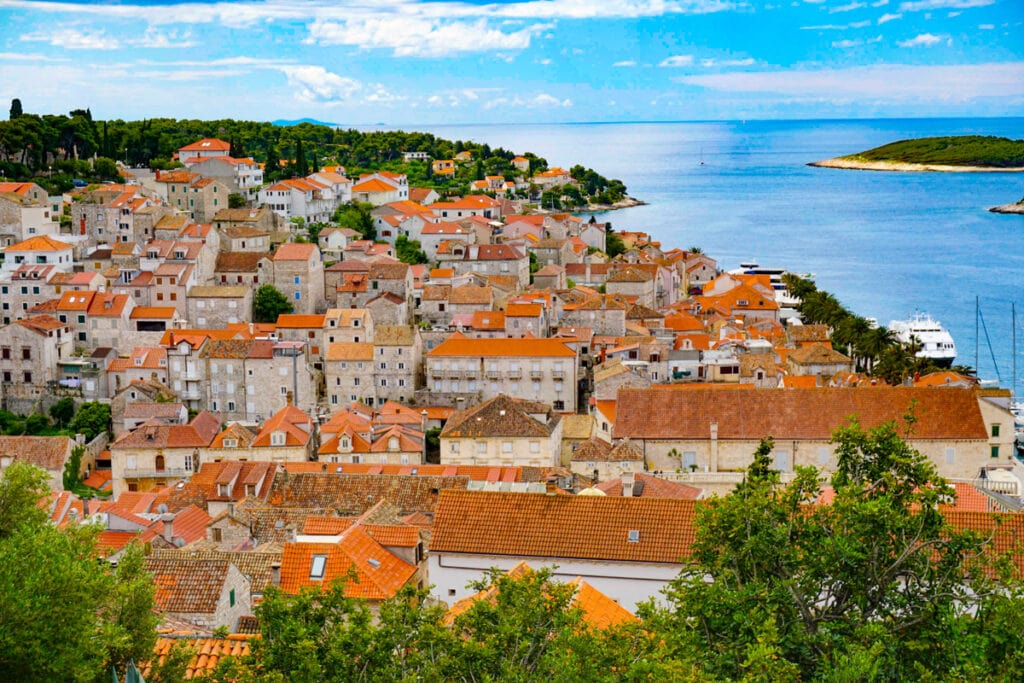
Getting to Hvar
If you have a car, you can take the car ferry to Hvar if you want to drive around the island. But when visiting for the day, we think it’s much easier to travel by catamaran and spend your day in Hvar Town.
Catamarans depart from the Port of Split and arrive in Hvar Town. You can walk to the ferry boarding area from Split Old Town in about 10 minutes.
Catamarans are stable air-conditioned vessels, and the journey takes about one hour each way. There are many departures in both directions between April and October, and more limited runs in November.
Jadrolinija and Kapetan Luka are the two companies that operate catamaran service between Split and Hvar.
Getting Around in Hvar
Hvar Town is small and easily walkable. If you also want to visit Stari Grad, or explore more of the island, you may want to rent a scooter or a quad bike, or you can take the local bus. The ride from Hvar Town to Stari Grad is about 30 minutes.
What to See and Do in Hvar
Walk the large Saint Stephen’s Square, where you can enjoy people watching. Visit the Hvar Cathedral on the square, and then wander the alleyways of the town.
Walking up to the Spanjola Fortress is a must-do! You can also arrive by taxi if you’d rather not walk. The views over the rooftops of Hvar Town, the blue Adriatic, and the outlying Pakleni Islands are gorgeous.
Step inside the beautiful Franciscan Monastery, where the museum is worth browsing, and stroll the Riva, the waterfront promenade.
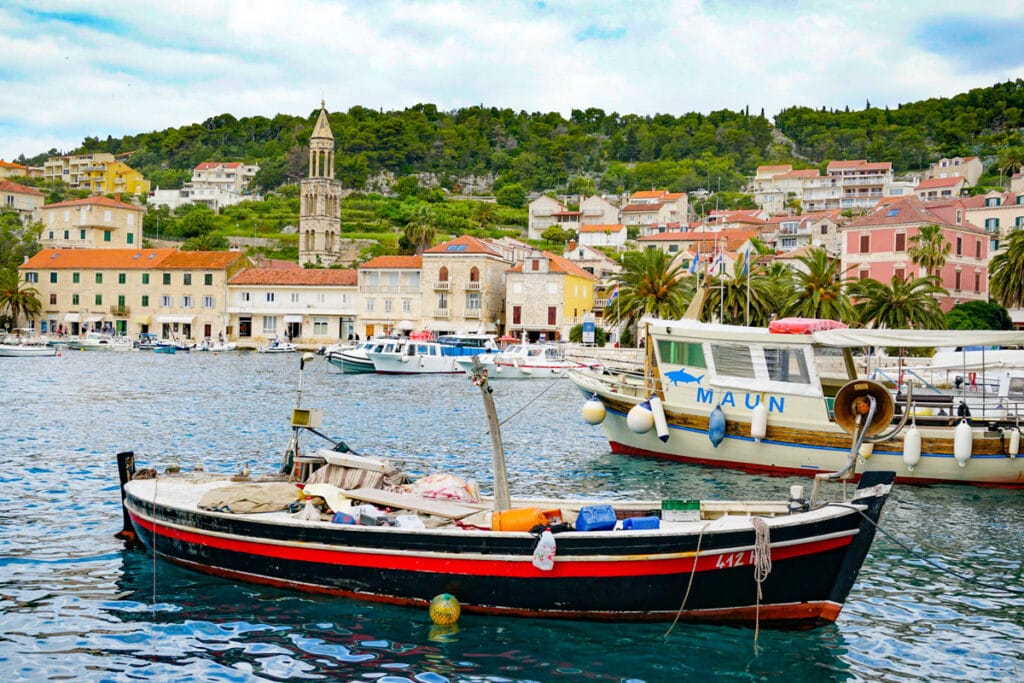
If you are up for a walk, there are many beautiful beaches near Hvar Town: Bonj Beach is about a 10-minute walk, and Pokonji Dol about a 25-minute walk.
Or take the bus to Stari Grad, a much quieter little town where you can wander the alleys, visit the Dominican Monastery, and explore Tvrdalj Castle.
Or take a boat ride to the Pakleni Islands, the jewel green islands you can see from the fortress in Hvar Town. The calm bays are perfect for swimming in the warmer months. You can also snorkel or find a beach for sunbathing.
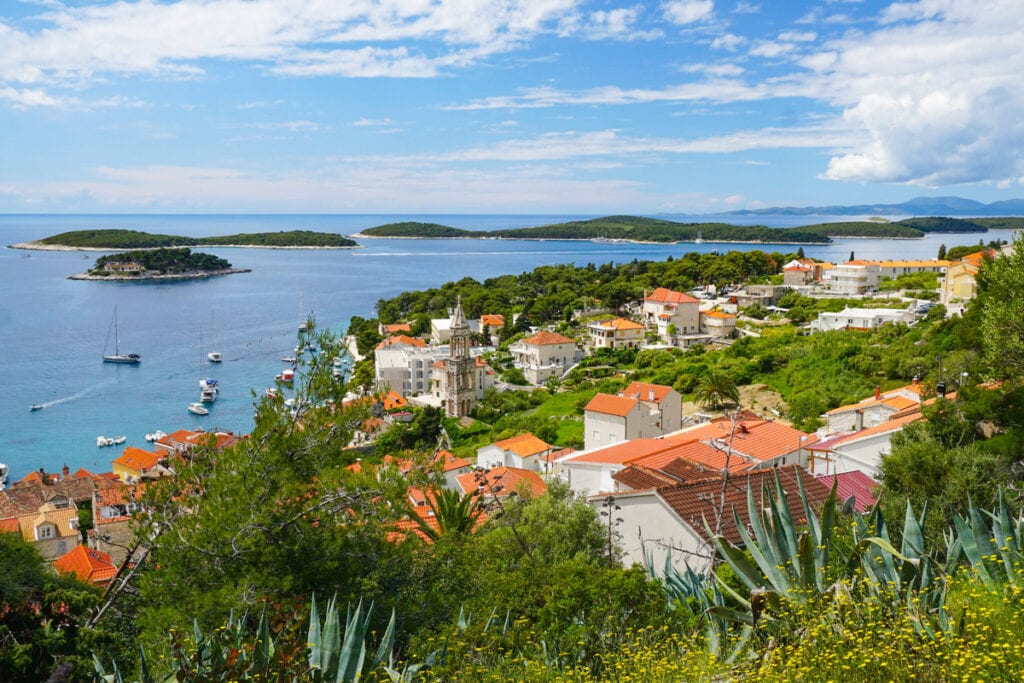
Taking a Guided Tour of the Islands
This immensely popular guided speedboat tour is an excellent option if you want to spend the day on the water and visit several islands.
The 10- to 12-hour excursion includes Croatia’s Blue Cave, one of the most visited tourist destinations along the Croatian Coast.
Your day begins with a visit to Bisevo, the small island that’s home to the Blue Cave. If conditions are conducive, the Blue Cave features stunning blue water, caused by sunlight reflecting off the white limestone on the sea bed.
Like the famous Blue Cave on Capri in Italy, the cave here has a low entrance, so you’ll need to transfer to small wooden boats and lie flat as you enter.
If conditions do not allow for visiting the Blue Cave, you’ll visit other caves.
Next you’ll visit the pretty fishing village of Komiza on the island of Vis, followed by a swim and beach time at the stunning Stiniva Cove.
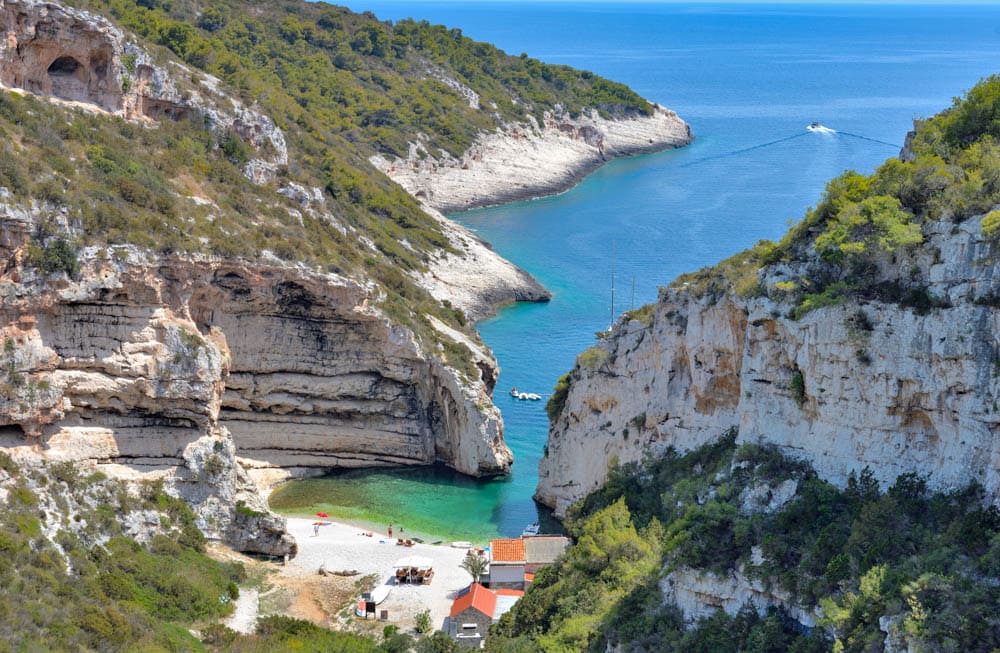
Then you’ll snorkel in the lovely Blue Lagoon at Budikovac Island (gear is provided), followed by free time in Hvar Town, where you can lunch and enjoy the sights we’ve described above.
Day 7: Do a half-day trip to Trogir or Omis, Travel to Dubrovnik
Before you leave for Dubrovnik, you have a part-day that you can use to visit the historic town of Trogir, or enjoy some adventure at the Cetina River in Omis, depending on your interests.
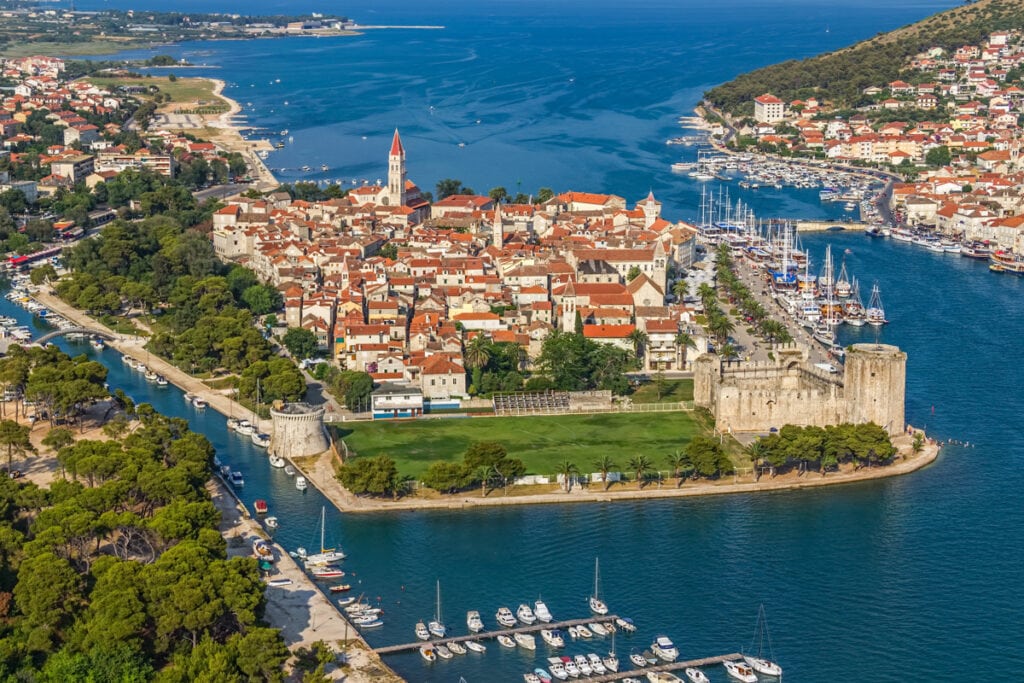
Trogir is tiny and charming. It is designated a UNESCO World Heritage Site, and a must-visit if you enjoy history and architecture. Wandering this tiny town is one of our favorite memories from our first trip to Croatia.
Omis, located at the mouth of the Cetina River, is an adventure mecca. Go canyoneering, whitewater rafting, ziplining, and more!
Getting to Trogir or Omis
Trogir is located on the Dalmatian Coast, a short distance north of Split. If you have a car, driving to Trogir from Split takes about 30 minutes in normal traffic.
You can also take the bus to Trogir from Split: there are numerous departures each day, and the journey takes about 30 minutes. In season, you can also take the ferry, although the ferries depart less frequently than the bus.
Omis is also located on the Dalmatian Coast, about 30 minutes south of Split. If you are traveling by car, you can continue onwards to Dubrovnik from Omis instead of returning to Split.
Public buses connect Split with Omis if you do not have a car. There are multiple departures in both directions each day. You can also do a guided adventure tour from Split.
Getting Around in Trogir or Omis
The historic centers of both Trogir and Omis are small, and you can explore the towns on foot.
What to See and Do in Trogir
Trogir’s historic center features stone architecture and picturesque alleys. Wandering the town to admire its beauty is one of the top things to do in Trogir.
Admire the gorgeous facade and main entrance of the Cathedral of St. Lawrence, and step inside to view the beautiful interior. The carved entrance is simply stunning.
Climb to the top of the bell tower of the cathedral for expansive views over the water and the rooftops of the Old Town.
Trogir’s main square has lovely buildings on its periphery, from City Hall to the Clock Tower and loggia and the Cipiko Palace. The square is a great place to have a drink and people watch.
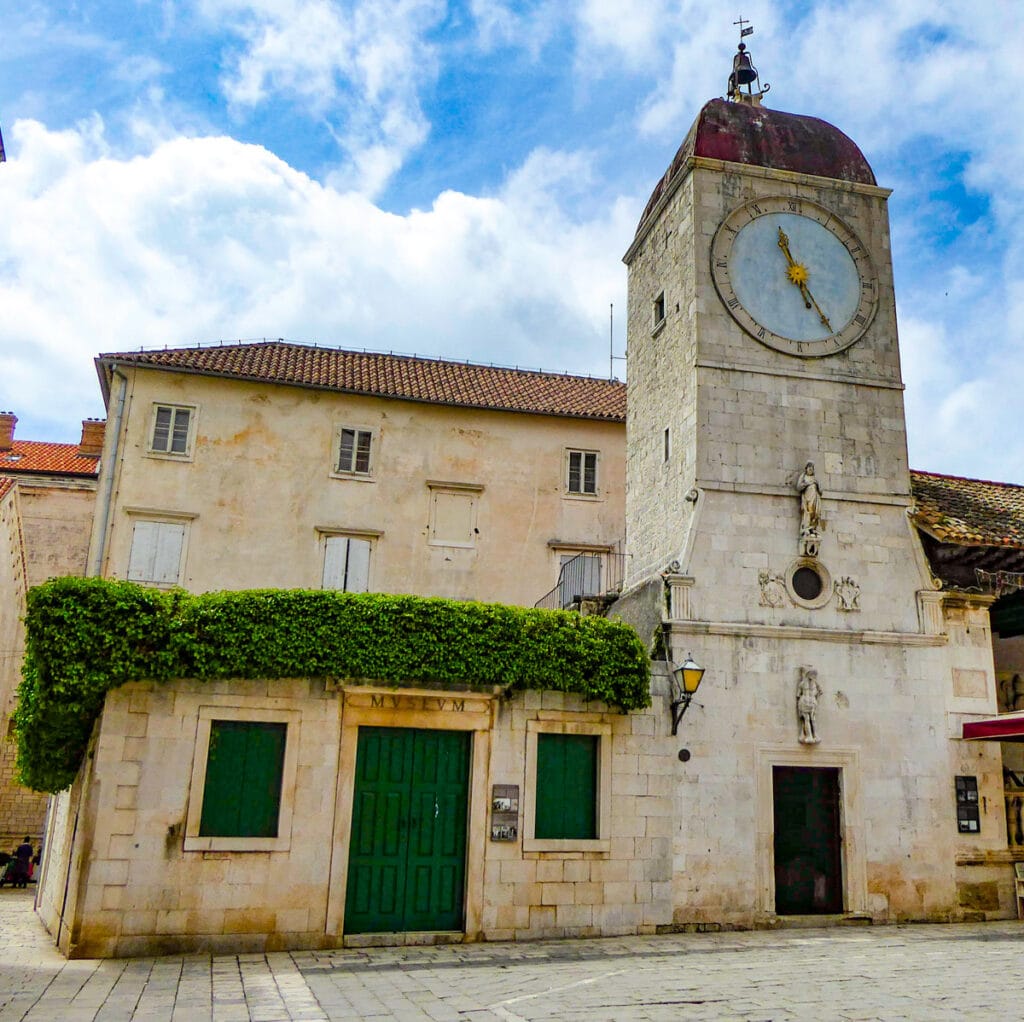
Along the picturesque Riva, or waterfront promenade, you’ll find the Kamerlengo Fortress. Climb the walls for great views!
Take a water taxi to the beach at Okrug Gornji if you do not have a car. The beach is pebbly but long and lovely.
What to See and Do in Omis
Omis has a stunning location, where the blue-green Cetina River flows into the Adriatic Sea. Its Old Town makes for a great wander.
There’s a hilltop fortress from where you get stunning views of the town rooftops, the river, and the sea. The beach in the Omis city center is clean and a great place to relax.
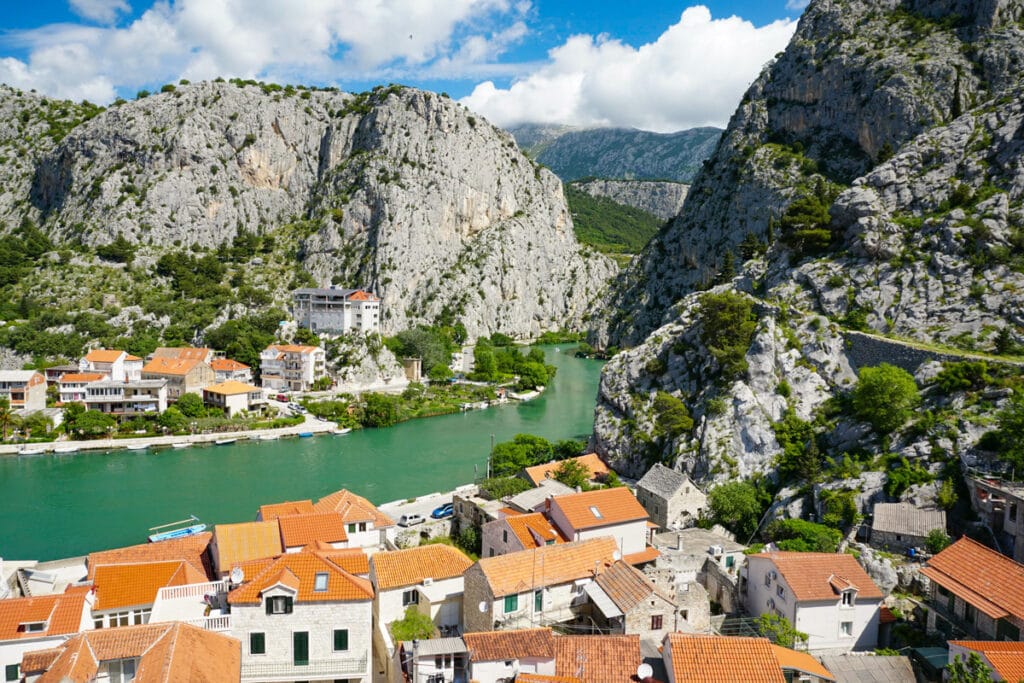
But adventure-lovers visit Omis for all the thrilling action you can find here, from ziplining to via ferrata and rafting to canyoning. Consider this highly-rated canyoning tour from Split, or this half-day rafting experience on the Cetina River with cliff jumping.
Or book this very popular zipline adventure over the Cetina River!
Whether you choose Trogir or Omis to explore, plan to return to Split in time to catch an evening bus to Dubrovnik, or drive on from Omis to Dubrovnik in the evening. You’ll want to have two full days to enjoy the beauty of Dubrovnik, the crown jewel of Croatia.
Days 8 and 9: explore Dubrovnik
Undoubtedly one of the best small cities to visit in Europe, Dubrovnik easily deserves its title of “Pearl of the Adriatic.”
Old Town Dubrovnik, which juts out into the Adriatic, is impossibly stunning, with many beautiful palaces, a striking main street, picturesque alleys on either side, and a pretty harbor.
If that’s not enough, there are also beautiful beaches for some relaxation in the sun, and excellent dining options.
In 2 days in Dubrovnik, you have plenty of time to explore the Old Town.
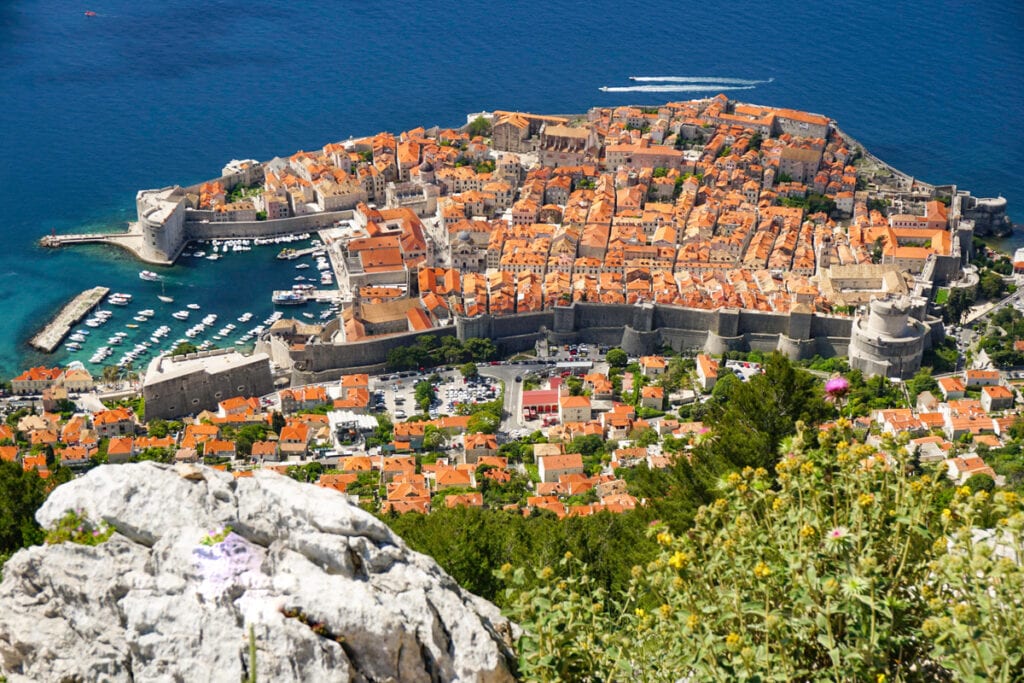
Getting into Dubrovnik
If you are planning to do a Croatia road trip, you can drive from Split to Dubrovnik in about 2 hours and 45 minutes in normal traffic.
If you do not wish to drive, you can take the bus from Split to Dubrovnik. The journey time is about 4 hours and there are several departures everyday.
In season (May-October or June-September, depending on the line), you can take the foot passenger ferry from Split to Dubrovnik. The journey time is about 4 hours and 40 minutes. One ferry departs in the morning and another in the afternoon.
Getting Around in Dubrovnik
Dubrovnik Old Town is small (and a pedestrian only zone), and you can walk everywhere.
And for short trips outside (to Mount Srd, for example, if the cable car isn’t functioning), you can use taxis or Uber.
What to See and Do in Dubrovnik on Day 1
The best thing to do in Old Town Dubrovnik is to walk the city walls. The views over the orange rooftops and the blue Adriatic are sensational. You can walk on your own, or if you are a history buff, consider this highly-rated guided tour of the walls.
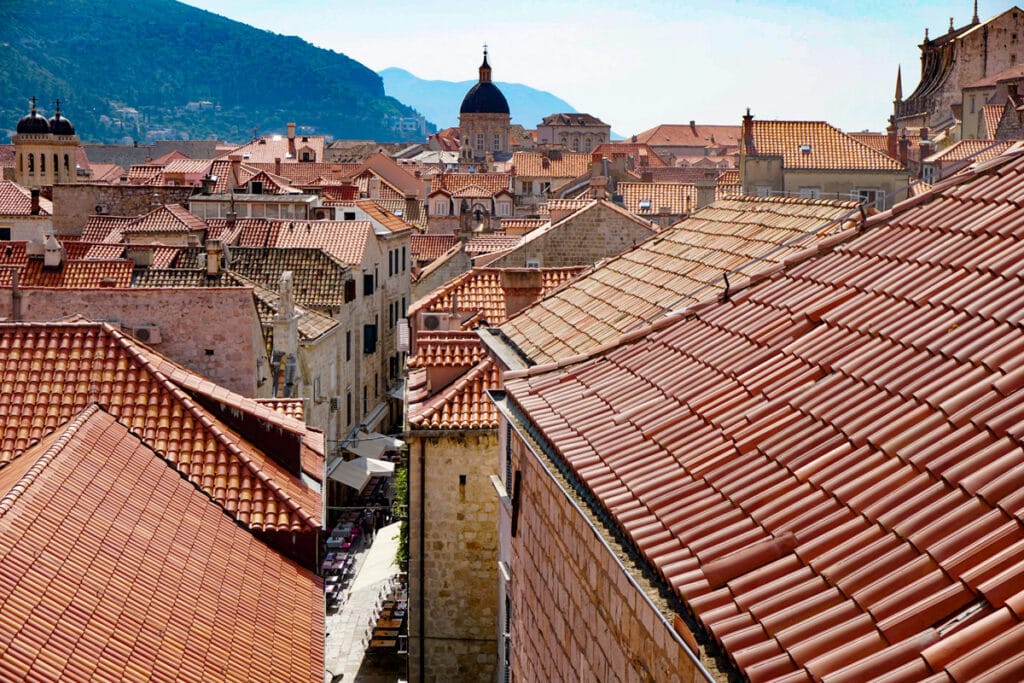
Dubrovnik’s walls were built between the 13th and the 16th centuries, mainly to keep out the Ottoman Turks. They are well preserved, and you can walk the entire length, about 2 km (1.5 miles).
The walls of Dubrovnik are a hugely popular attraction, so arrive at opening time to beat the crowds. You’ll also escape the heat: the entire walk is exposed.
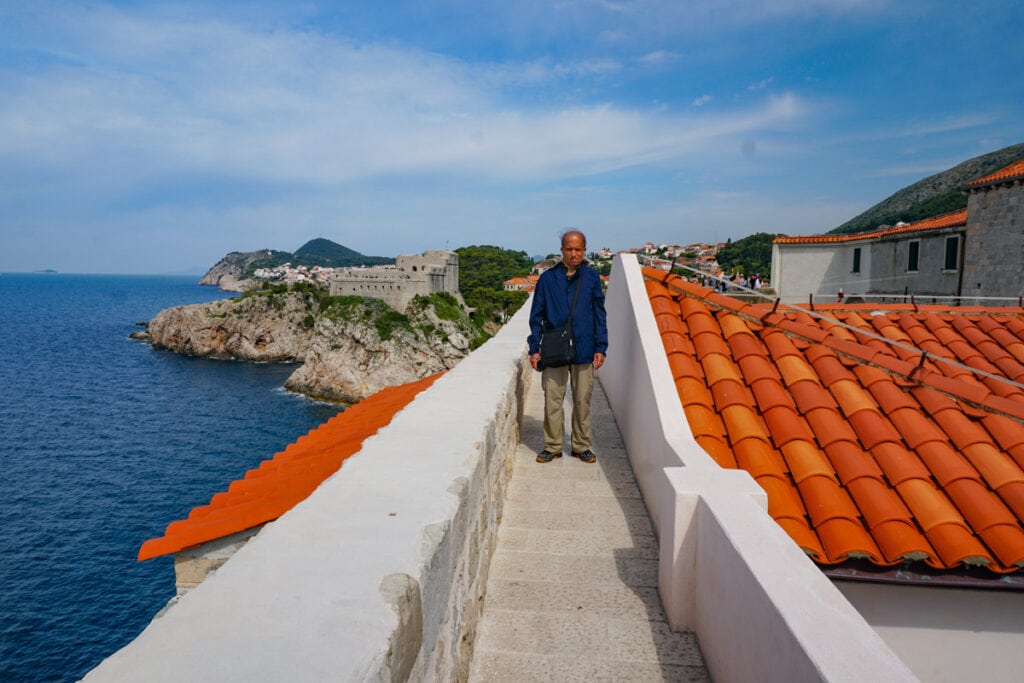
In the afternoon, explore other sights in the Old Town. This popular and highly-rated walking tour is an excellent way to learn as you explore.
Foodies will want to consider this 3-hour food and drink walking tour with a local guide: we skipped a sit-down lunch and took this tour instead.
Walk Stradun, the gorgeous main street, to admire the architecture, browse the shops, and enjoy a spot of people watching. If you stop for a drink, note that it will be very pricey.
Admire the gorgeous facade of the Rector’s Palace, and browse the museum within. Step inside the Dubrovnik Cathedral, which houses The Assumption by Titian, and the Church of St. Blaise, with its ornate interior.
Snap photos of the Jesuit Staircase, which featured in Game of Thrones, the slender Orlando’s Column, and the Clock Tower, which dates from the 15th century.
The Franciscan Monastery is a must-visit for its gorgeous cloisters. The cool and serene interior is home to a small museum and a historic pharmacy. The Large Onofrio’s Fountain, near the monastery, is another great photo spot in the Old Town.
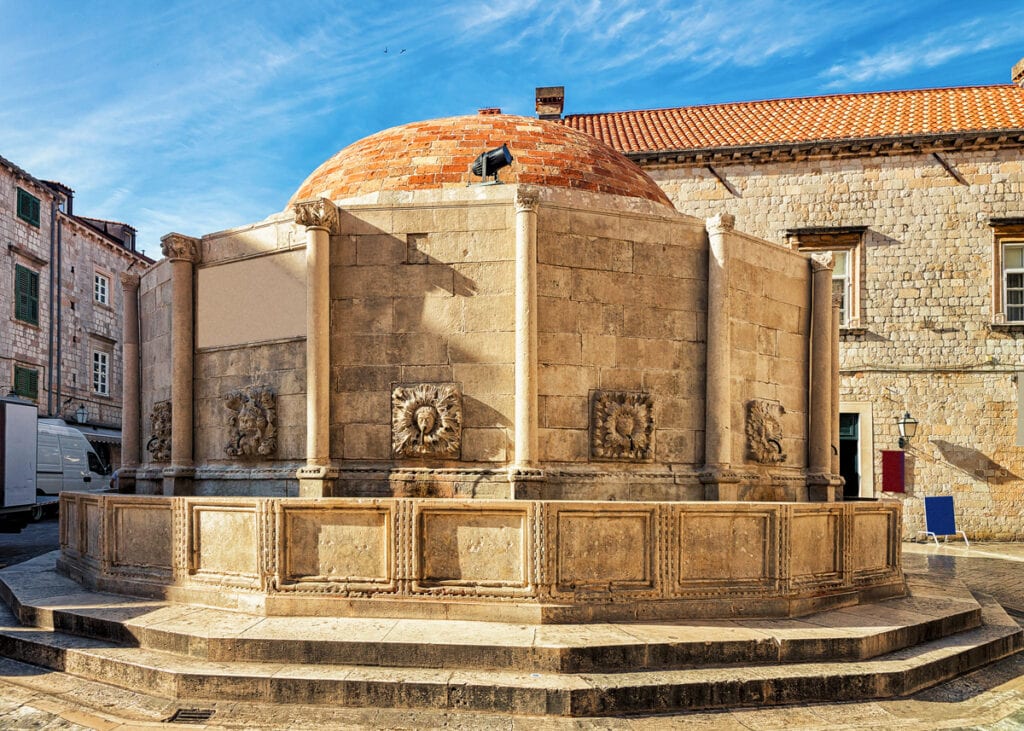
In the evening, take the cable car to the top of Mount Srd for panoramic views over Old Town Dubrovnik and the Adriatic Sea. Sunset here can be spectacular.
Afterwards, enjoy dinner and drinks at one of the many fine restaurants in town. We enjoyed the views and the Mediterranean cuisine at Above 5, a fifth floor terrace restaurant right in the Old Town.
What to See and Do in Dubrovnik on Day 2
Start your day with an exploration of Fort Lovrijenac, from where you get stunning views of Dubrovnik. Your ticket for the city walls also provides access to the fort.
Next, walk through the arches to the Old Port, scenic in its own right but also the departure point for boat tours. The pier dates back to the 15th century.
Take the ferry to Lokrum Island. It’s only a 15-minute ride, and there are regular sailings through the day in season.
Once on the island, you can stroll the walking trails, check out the ruins of the Benedictine monastery, enjoy the pebbly beaches, and snap photos of the resident peacocks.
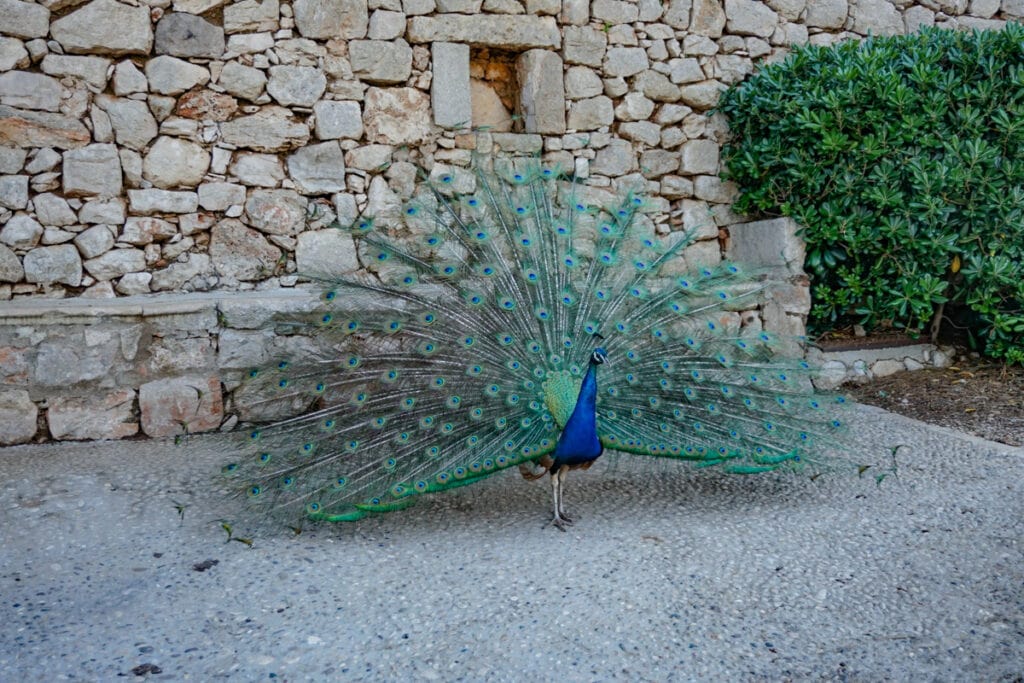
In the afternoon, catch some sun or swim at one of the beaches in the area. Afterwards, stop for a drink at the must-visit Buža Bar!
The pebbly Banje Beach, located by the Ploče Gate, offers beautiful views of the Old Town and Lokrum Island. It’s hugely popular.
Sveti Jakov Beach is a little further out, but also offers great views of the Old Town, and loungers for rent.
If you’d rather do something active on the water, book a guided sea-kayaking tour. This highly-rated tour goes past the city walls to Betina Cave, where you can swim, or enjoy snorkeling or cliff-jumping, before paddling around Lokrum Island on your way back.
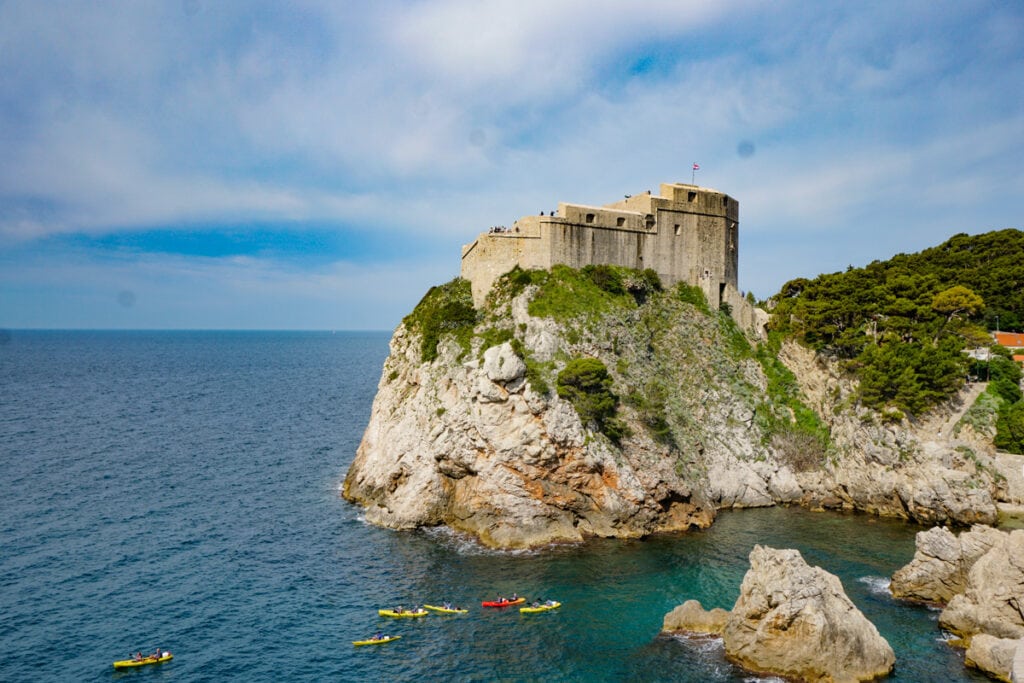
Game of Thrones fans also have the option of taking a guided walking tour focused on GOT locations. Dubrovnik served as King’s Landing in the famous series.
End your day with dinner and drinks. There are many rooftop bars in Dubrovnik, where you can relax with drinks over a stunning view. Stara Loza’s rooftop bar is an excellent place to drink and dine.
Where to Stay in Dubrovnik
Luxury: We spent two nights at Villa Dubrovnik on our first visit to Croatia. Set into the cliffs, the hotel offers fabulous views of the sea and Old Town Dubrovnik.
Rooms are elegantly furnished and the hotel offers a pool and a rooftop bar. Breakfasts here are exceptional. You can take the complimentary shuttle into the Old Town.
Luxury: The Pucic Palace is a boutique hotel located in a beautifully restored building in the heart of the walled Old Town, near the Jesuit staircase.
Rooms are well-appointed and you can have breakfast on the terrace each morning. The onsite rooftop restaurant is highly rated as well. In season, you’ll find a green market just around the corner!
Mid-Range: Heritage Villa Nobile is located just outside the Old Town. The hotel offers just six rooms, each individually decorated. Beds are rated super comfy and service exemplary.
Breakfast, highly rated, is served on a terrace located in the tranquil gardens.
Mid-Range: Berkeley Hotel & Spa is a boutique property located in the Gruz Harbor area, about 2 km (1.2 miles) from the Old Town. You can walk or take the bus or a taxi into the Old Town.
The property offers 25 spacious rooms with patios or balconies. The hotel has an outdoor pool and a sun deck, as well as a day spa and sauna.
Day 10: Say goodbye to Croatia!
Sadly, your 10-day Croatia itinerary is now complete, and it’s time to say goodbye to this gorgeous country. If you are like us, you will spend your return journey planning your next visit to Croatia!
The Ultimate 10 Days in Croatia Itinerary: Overview + Map
Day 1: Arrive in Zagreb, explore Zagreb
Day 2: Travel to Plitvice Lakes, explore Plitvice Lakes National Park
Day 3: Travel to Zadar, explore Zadar
Day 4: Visit Krka National Park and Sibenik
Day 5: Travel to Split, explore Split
Day 6: Take a day trip to Hvar, or do a multi-island tour
Day 7: Do a part-day trip to Trogir or Omis, travel to Dubrovnik
Days 8 and 9: Explore Dubrovnik
Day 10: Fly home or travel to your next destination
Here’s a map that shows our Croatia itinerary for first-timers:
Looking for a 10-day Croatia itinerary starting in Dubrovnik? Although we’ve described this itinerary as starting in Zagreb and ending in Dubrovnik, you can do it in the reverse direction as well, starting in Dubrovnik and ending in Zagreb.
More Time in Croatia? Add to Your Croatia Itinerary!
With more time, there are plenty of places that you can add to the major hubs on this 10-day Croatia itinerary!
If you have one additional day in Zagreb, consider a day trip to the Istrian coast!
Rovinj is one of the prettiest places in Croatia, Pula has a stunning Roman amphitheater, and Poreč has the beautiful Euphrasian Basilica, a UNESCO World Heritage Site. This private tour is an efficient way to go if you do not have a car.
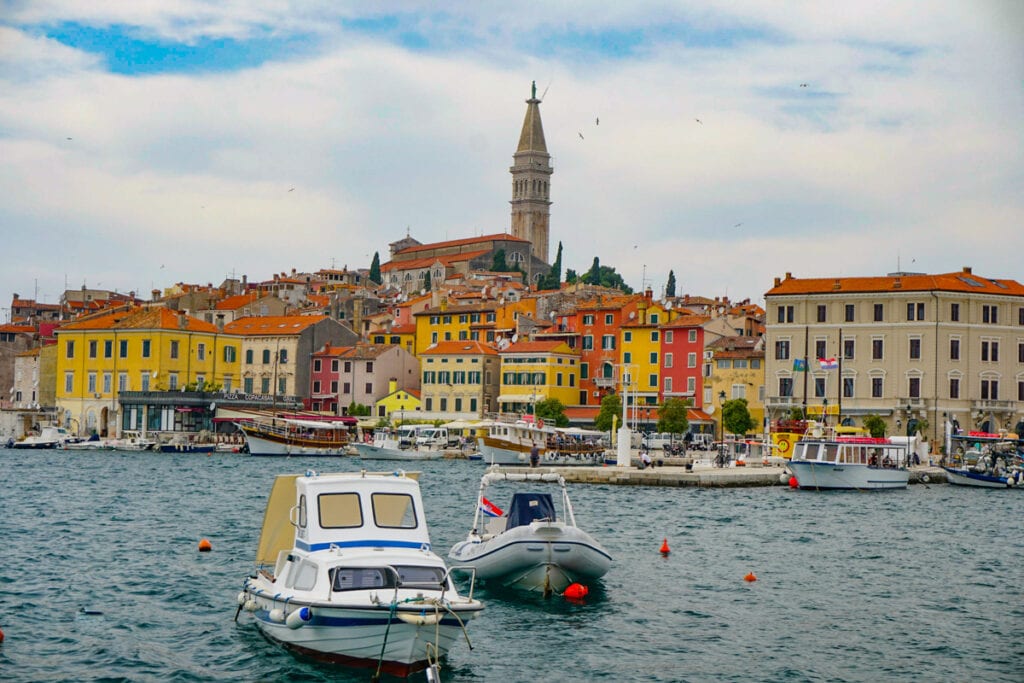
With another day, consider a day trip to another country! Ljubljana and Lake Bled, in nearby Slovenia, make for a delightful excursion. Here’s a highly-rated guided tour if you do not wish to drive.
If you wish to spend a day exploring smaller places near Zagreb, Samobor and Varazdin are excellent options.
With an additional day in Zadar, consider a full-day guided tour to the gorgeous Kornati National Park, yet another of Croatia’s beautiful national parks.
Between Split and Dubrovnik, the Dalmatian Coast has many places to enjoy, if you have an additional day or two. Omis is the adventure capital of the region. The Makarska Riviera is home to beautiful beaches. Korcula is a super picturesque island.
If you plan a more in-depth exploration of the coast, be sure to check out our detailed Croatia coast itinerary.
If you have more time in Dubrovnik, you can take a day trip to Montenegro. Boka Bay is very scenic and Old Town Kotor is well worth wandering. Here’s a guided tour if you do not wish to drive.
Or take a day trip to historic Mostar in Bosnia and Herzegovina. You can go on your own or join this highly-rated small group guided tour.
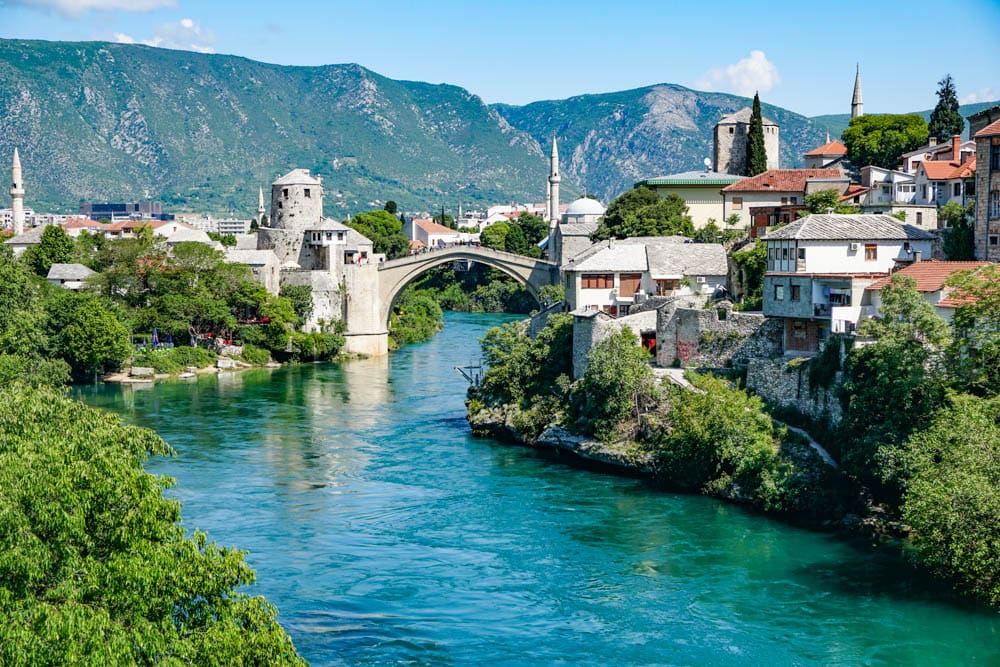
Getting Around in Croatia
The important thing to know is that unlike countries like Italy and Spain, Croatia does not have an extensive train network.
Croatia does have excellent highways and a great network of roads, so it’s an ideal destination for a road trip. Renting a car will give you great flexibility and allow you to travel with ease through a Croatia itinerary.
Looking to rent a car for your Croatia road trip? Consider Discover Cars! They work with numerous car rental agencies, both brand and budget, to get you the best deal.
If you do not wish to drive, Croatia does have an extensive bus network. All of the places we’ve described in our itinerary can be covered using the bus network (with guided tours for some day trips).
We’ve traveled by public bus in Croatia when doing day trips, and we’ve found them pretty clean and comfortable. The buses we took were on time, too!
To book bus tickets for Croatia in advance, consider Omio. The website is in English, and we found the booking experience easy and hassle-free. They do charge a small service fee but we thought it was well worth the convenience!
The Best Time to Year to Enjoy This Croatia Itinerary
Spring and fall are the best times of the year to visit Croatia. These shoulder seasons offer pleasant weather and lower crowds than in the peak summer season. Bring layers and rain gear!
In spring, waterfalls at both Plitvice Lakes National Park and Krka National Park will be in full flow. You’ll find lots of wildflowers, both in the parks and along trails and roadsides.
Daytime highs in the spring range from mid-60s Fahrenheit in April to low 80s in June. Typically, expect 6-8 days of rain in each of these months.
You will likely not be able to swim in the sea until late May or early June, so if swimming is important to you, pick early fall instead, or prepare to brave the crowds of summer.
In the fall, you’ll find beautiful leaf color in the national parks and in the countryside.
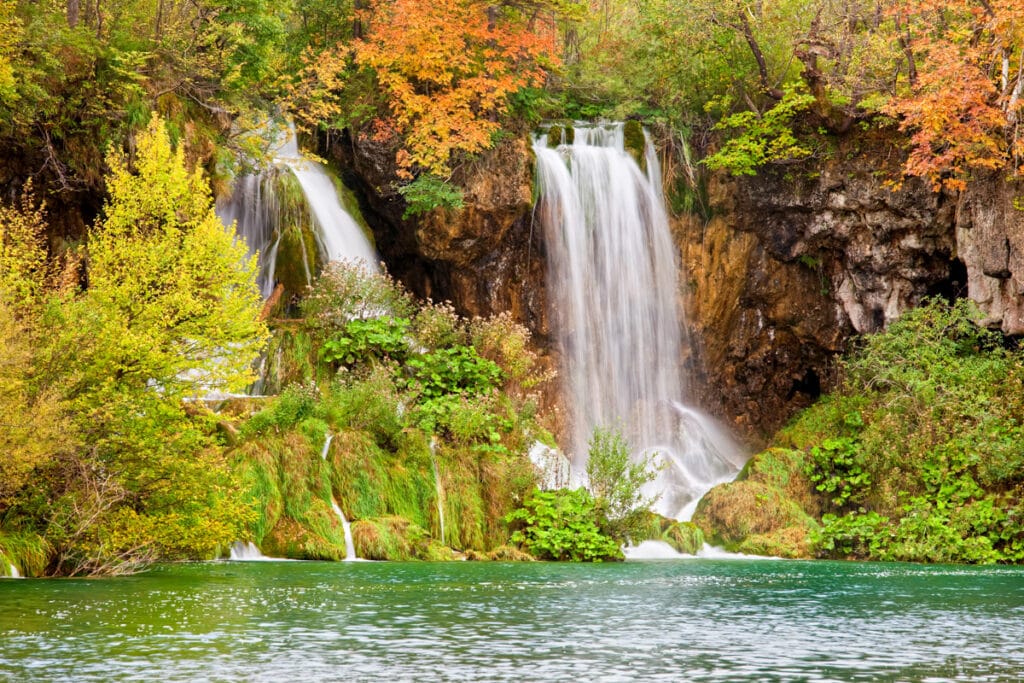
Daytime highs in the fall range from low 80s in September to mid-60s in November. Expect the interior to be colder than the coast in late fall. You’ll likely see a few days of rain in September and October, and more so in November.
Summer offers the best beach weather, plus long daylight hours and the most extensive schedule of ferries and water-based tours. It is high season in Croatia, so expect crowds at popular destinations, as well as higher prices.
Good to know: Places like Dubrovnik and Split have a long cruise ship season, and on days that cruise ships are in port, the historic centers overflow with tourists. If possible, plan your visits to busy cruise ports on days that ships are not expected.
Winter is not a bad time to visit Croatia if you are okay with forgoing activities at sea and focus on sightseeing in larger cities where most places are open year round.
Historic centers and national parks are delightfully uncrowded, and accommodation prices are lower. Zagreb is famous for its Advent Markets and one of the best cities to visit in winter in Europe.
Frequently Asked Questions
10 days in Croatia is adequate time to take in some major sights and get a little sense for the country’s history, culture, and natural beauty. If you have just 10 days in Croatia, be sure to spend time in stunning Dubrovnik, take a trip out to the islands from Split, and view the surreal waterfalls of Plitvice Lakes National Park. These are the bucket list experiences for any first visit to Croatia.
Spring (May-June) and fall (September-October) offer pleasant weather and lower crowds than the peak of summer. In the spring, you’ll see lots of wildflowers in the parks, and fall offers great leaf peeping. Of course, summer offers long daylight hours and the best beach weather, so if swimming is on your itinerary, visit in the summer.
The best way to get around Croatia is by car. A car offers convenience and flexibility, allowing for impromptu stops as you are traveling the beautiful coast. The country has a great network of roadways, but no widespread train network, so if you do not wish to drive, buses are the commonly-used means of public transport, as well as ferries along the coast.
The Dalmatian Coast is the most popular tourist destination in Croatia. Here you will find Dubrovnik, known as “the Pearl of the Adriatic,” and Split, where the Diocletian Palace is a UNESCO World Heritage Site. There are many other charming coastal towns as well as idyllic islands that lie offshore.
Did you find this article informative? Pin it for later reference!
